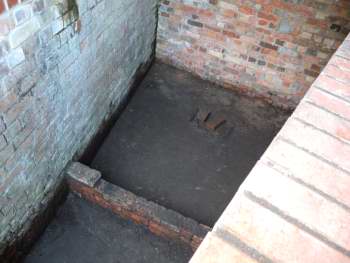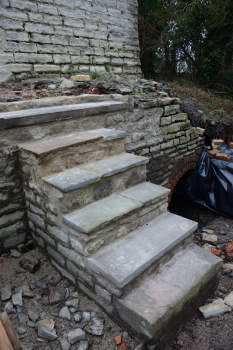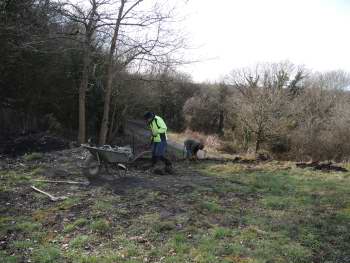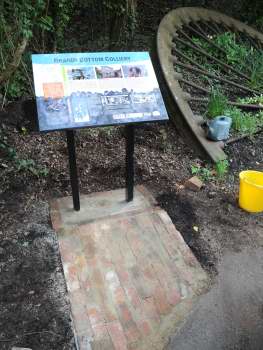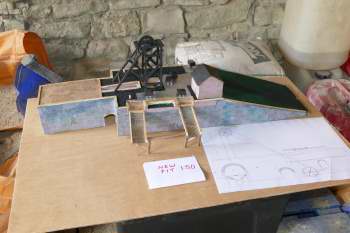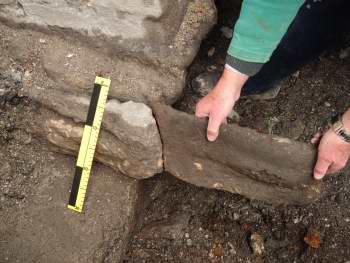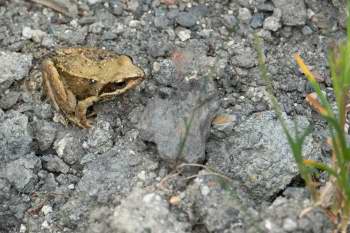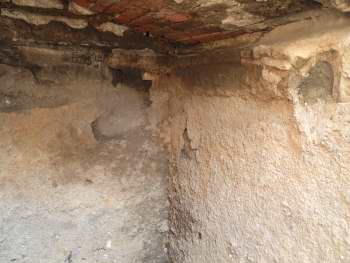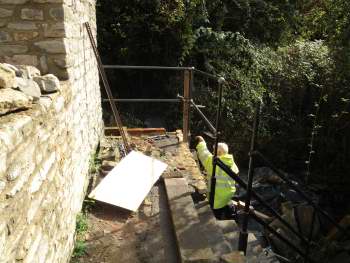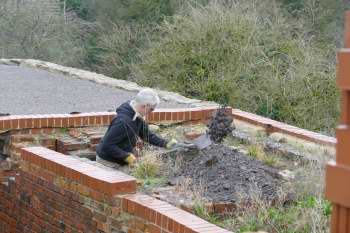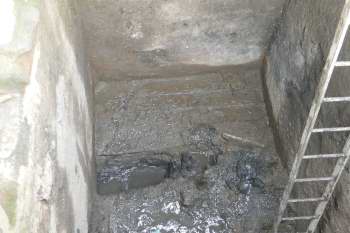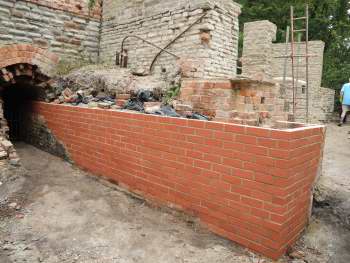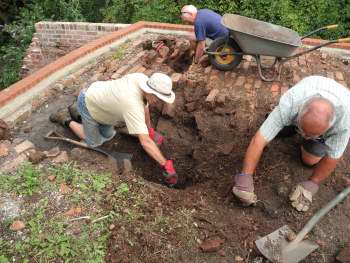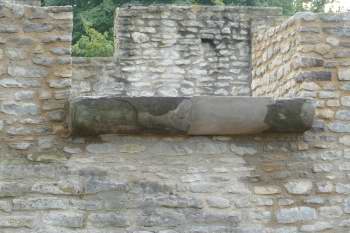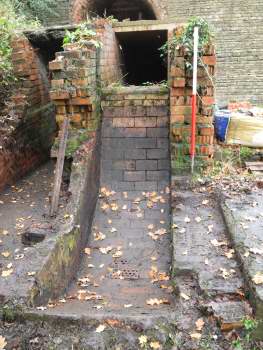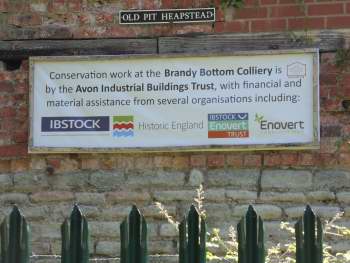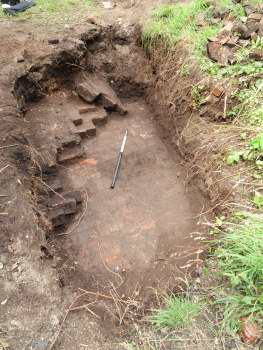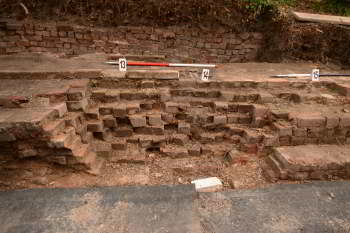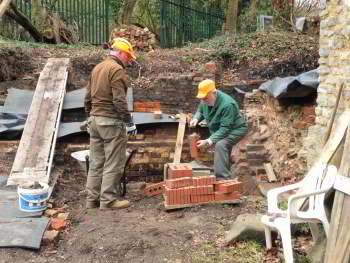 |
|
     |
|
Other Brandy Bottom PagesAs well as an introductory page, the other Brandy Bottom pages cover the history, and the AIBT's conservation work at the site. The latter is divided into several pages of photos of the buildings, work parties, finds, and nature. There are also images of the display boards, and a page with a location map, plus directions to the site and the dates of work parties. Progress at Brandy BottomThe AIBT would like to thank Ibstock, Historic England, the Ibstock Enovert Trust (formerly known as the Ibstock Cory Environmental Trust), the Enovert Community Trust, and the South Gloucestershire Council for their financial and material assistance to the conservation work at Brandy Bottom. They are also grateful for the help given by members of other organisations, such as the South Gloucestershire Mines Research Group, and by people living nearby. (Go to work parties in 2011, 2012, 2013, 2014, 2015, 2016, 2017, 2018, 2019, 2020, 2021, 2022, 2023) 2008-9The lease with the site owners, Ibstock, was signed in late 2008, allowing the AIBT to start work on the site. This included development of the site conservation plan under the direction of the consulting architects, JH Consulting, of Bath. The plans were also discussed with Historic England, who made site inspections. Site and topographical surveys, and rectified photography of the surviving walls, were completed by the end of 2008. 2010There were 6 work parties at the site during the year, including a further site inspection by Historic England on 24 June. During the year, the main focus of work at the site was cutting back the vegetation growing around all the buildings and on the top of the northern heapstead. At the same time the ivy growing on the walls of the two building complexes was trimmed, both to weaken the ivy and to reduce the load it imposes on the structures. The location of the shaft associated with the Vertical Engine House in the northern complex was discovered on 28 August. On 30 October, cutting back the shrubs growing inside the ruined Vertical Engine House uncovered the securing bolts for the machinery. Photo right: Clearing out the chimney flue, October 2010. Photo by G Travers The floor of the Horizontal Engine House in the southern complex was cleared of rubble on 11 August, making it easier to monitor the deterioration of the roof. At some time in the past the tie rods that bound the walls together have been removed, allowing the walls to spread under the weight of the arched roof. Markers have been installed on the resulting cracks so that any further deterioration can be measured. The last stage of clearing the flue at the base of the chimney was finished on 30 October, allowing the condition of the brickwork of the flue and the lower part of the inside of the chimney to be checked. This appears to be in good condition. The state of the brickwork on the outside of the chimney has still to be surveyed. A planned inspection of the chimney from a helicopter had to be abandoned, and alternative ways of making the inspection are being looked at. Most of the outside masonry and brickwork seems to be in a reasonable condition, though there are some areas at the top that will need attention. The history of the pit was being investigated, and is being written up as a report. (Go to work parties in 2008-09, 2010, 2012, 2013, 2014, 2015, 2016, 2017, 2018, 2019, 2020, 2021, 2022, 2023) 2011There were a total of 17 work parties during the year. The first, on 03 March, saw an earlier start than in 2010 to the endless struggle against the encroaching vegetation. The scrub growing on the top of the southern heapstead and horizontal engine house was cut back to soil level. As a result we were able to locate the shaft capping associated with horizontal engine. The ivy, and other vegetation, growing on the walls of both complexes was trimmed back, both on this and the subsequent sessions. A visit on 26 March by a local expert on Cornish Engines showed us where some of the securing bolts for the cylinder of the Cornish Engine House could be found, and the position of the associated shaft for the pump rods. Photo right: Details of masonry at top of the chimney, June 2011. The cold weather at the turn of the year has not kind to the roof of the horizontal engine house, and there has been more spalling of the brickwork and widening of the roof cracks. Reinstallation of the tie rods should control the movement. However the consent of Historic England was first required as Brandy Bottom is a scheduled ancient monument. This was given, and new rods were ordered from a local supplier. This is the first time we have had to ask Historic England to approve conservation work, but there will be more occasions in the future as work proceeds. Historic England Heritage has also recommended that the roof of the engine house is waterproofed to minimise any further damage from water. An old layer of tarmac was discovered on the roof during the scrub clearance on 03 March. That has obviously become porous with age, but may provide a foundation for a new protective waterproof layer. The state of the masonry on the chimney was surveyed from the ground on 18 June, using a camera and telephoto lens rather than a helicopter. A start was made on clearing spoil from the passage between the Cornish Engine House and the adjacent pit, with the aim of making access easier to the areas behind. A photo taken in July shows work in progress. Among the finds in this area have been a large bolt and what looks like a bearing attached to a trunnion. These may have come from the beam of the Cornish Engine. Two tie rods were installed in the New Pit Horizontal Engine House on 09 July, and a third tie rod on 30 July. On the latter date vegetation was cleared from its roof and the top of the associated heapstead. The expert on Cornish Engines made a second visit, and provided useful advice on both the layout of the Cornish engine and associated beam, and of the layout of the Vertical Engine House in the north-east of that complex. He also confirmed that the bearing found earlier was a parallel motion anchorage point from the beam of the Cornish Engine. More vegetation was cleared from the top of the Horizontal Engine House on 17 August, when a large Hawthorn stump was wrestled into submission and removed. Its roots may have penetrated the hard layer on the top of the roof, and contributed to the damage to the underlying brick arch. This clearance work continued on 27 August, when the tops of the walls of the Horizontal Engine House were uncovered in two places. The earth and bricks covering the capping of the pumping shaft in the South Pit complex was removed, to reveal a concrete slab with 'Finish 1923' inscribed into the surface. This suggests that the beam engine had stopped working at some time before that date, though this has not yet been confirmed from historical records. Photo left: An uncovered section of wall on the top of the Horizontal Engine House, showing two bolts (? for securing baulks of timber ?) and channels in the masonry that may have held timber edge pieces, September 2011. On 03 September one group carried on with vegetation clearance on top of the Horizontal Engine House, revealing more about the layout of the masonry. The edges may have been capped by baulks of timber, as there are securing bolts at intervals around the edge. There are also shallow channels in the masonry, which could have been used to stop the bottom of the baulks moving. The area around the shaft capping in the South Pit complex, uncovered in the previous session, was tidied up. A start was also made on uncovering the engine beds in the vertical engine house associated with the South Pit. More of the Horizontal Engine House roof was uncovered on 24 September. Another Hawthorn stump was was uprooted, which led to the discovery of an area where bricks had been laid in the soil without using any mortar. Nor were they connected to the nearest wall, and why this was done is not clear. Photo right: Discussion on the layout of the engine bed, September 2011. Vegetation clearance continued on 17 October, and a start was made on clearing fallen masonry from the path along the side of the New Pit heapstead. This was substantially complete at the end of the next session on 24 October. Clearance of the path along the bottom of the South Pit heapstead was started on 05 November. A proposal was submitted to Historic England in November for the installation of a membrane on the roof of the Horizontal Engine House. The membrane will stop rain getting into the structure, which can lead to frost damage to the masonry. Brandy Bottom was one of the case studies in the Historic England's 2011 survey of Industrial Heritage at Risk, which was published on 19 October 2011. (Go to work parties in 2008-09, 2010, 2011, 2013, 2014, 2015, 2016, 2017, 2018, 2019, 2020, 2021, 2022, 2023) 2012There were 21 workparties in 2012. Photo right: Icicles in the passageway between the Horizontal Engine House and the New Pit Heapstead, February 2012. A start was made on establishing ground levels around the Horizontal Engine House walls, so that the walls could be repaired at a future date using a mobile scaffolding platform. The test trench made last year on the north-west corner of the house was extended southwards. This revealed that the brick floor continued along the length of the cleared area, and was still in good condition adjacent to the walls but deteriorated away from them. There were no finds. The clearance work continued along the wall of the Horizontal Engine House on 18 February, at least until rain brought a halt to proceedings at midday. This uncovered some brick steps to the doorway. Clearance work along the north-west wall was finished on 03 March, and a narrower strip was cleared on the other side of the engine house. The end wall was cleared on 17 March, uncovering a section of fallen wall just under the ground surface.This can be seen in the image below.
There have been further discussions with Historic England about waterproofing the roof of the Horizontal Engine House. This would also involve restoring some of the missing masonry from the top edges of the building's walls. The work will be done by a contractor, and quotes for the work are being sought. Rough levelling of the top of the Horizontal Engine House was finished on 31 March. The spoil was seived, and the fine fraction stockpiled for future use when countouring the roof for drainage. Two test trenches were dug along the side of the New Pit heapstead wall. Nothing of significance was found in one, located at the end where the slope down meets ground level. The other was at the engine house end, at a point where the stone facing of the wall had collapsed. There was no sign of these stones, which suggestes that they may have been removed at some time after the facing collapsed. One significant find here was a securing pin on a chain.
Ivy growing along the path side of the New Pit heapstead was cut back on 21 April to reduce stresses on the masonry of the wall. The roof was surveyed to establish the levels at various points. These measurements will be used in the design of the run-off slopes for the impermeable membrane. On 05 May a pile of debris was cleared from the path along the South Pit heapstead, at a point where the wall of the heapstead had collapsed. None of the missing stones were found, however an almost complete example of a roof tile was uncovered. Several broken tiles of this type had been found in 2011 outside the Horizontal Engine House, and other finds included what appears to be a track spike. Clearance work along the wall of the South Pit heapstead continued on 19 May, and again the missing stones were not found. Among the finds were two pieces of rail, one a piece of light rail with the remains of two fishplates and the other a length of tramway rail with joint holes. Markers were placed on the roof of the Horizontal Engine House to indicate the falls for the waterproof membrane. Photo left: Iron rim, possibly from a coal tub, found at the base of the Cornish Engine House wall, June 2012. More hawthorn stumps were uprooted on 30 June, and a start was made on clearing a section at the base of the north-eastern wall of the Cornish Engine House. This uncovered the stones that have fallen from the wall of the house, and these have been stockpiled for future re-use. There was also what appeared to be the iron rim of a mine tub, with one complete side 4 ft long, and two partial ends. Clearance work continued along the base of the wall on 14 and 28 July and finished on 11 August.
On 25 August work resumed on clearing a level path along the base of the South Pit heapstead walls, and this is now almost complete. The session on 15 September concentrated on the Cornish Engine House, and a somewhat moth-eaten set of steps were uncovered on the southern side of the building. The reason for the bolt near the top of the steps is being debated, but it may have anchored a set of handrails on either side. The steps led up to a platform running along the side of the wall. The wall of the house in the region of the steps has collapsed, so it is not possible to say if they led directly to an entrance. Clearance inside the Cornish Engine House continued on 29 September and 13 October. This has uncovered a quantity of building stone from the walls, which is being stockpiled for future reuse. Photo right: Flat plate found at base of one of the Cornish Engine House walls, Oct 2012. The full extent of the engine bed in the Cornish Engine House was uncovered on 24 October. This has an annular groove worn into the surface, and a crack running across it. The groove is worn unequally on either side of the crack. The outer diameter of the groove is 64" and the inner diameter 55", comparable with the known 60" diameter of the cylinder. Following agreement with Historic England, stone masons started repairs to the north-eastern wall of the Cornish Engine House at the end of October. They replaced the masonry that had fallen out of the wall, which had left the upper courses unsupported. The extent of the damage can be judged from a photo taken in 1965, which shows the wall to be largely intact. This work was completed in early November. Photos on both the 'Buildings' and 'Work Parties' pages of the website show the state of the wall before work started, the work in progress and the outside of the wall after the work was finished. This work was still in progress on 04 November, so attention was turned to clearing the area around the entrance to the flue to the chimney. The small group on 14 November worked on site maintenance, consolidating the remaining stocks of recovered masonry. (Go to work parties in 2008-09, 2010, 2011, 2012, 2014, 2015, 2016, 2017, 2018, 2019, 2020, 2021, 2022, 2023) 2013There were 18 work parties in 2013. The original 5-year licence from Historic England to work on site site expired in 2012, and is in the process of being renewed. Until then, the AIBT is restricted to vegetation control on site. As a result the first work party of the year was not until 02 March, when a start was made on clearing the vegetation from the fan housing. Vegetation clearance continued on 20 March, revealing that the fan housing extends over a larger area than originally thought. It is now possible to see clearly that one of the walls has been pushed out of true by pressure from the adjacent batch. This can be seen in the picture, which looks along the duct towards the New Pit heapstead, with the batch to the left. The task of relieving the pressure has been added to the list of things to be done at a future date ... Photo left: Looking along the fan duct towards the New Pit heapstead, March 2013. Work on the site tidy-up continued on 06 and 17 April, as well as 01 May. Many of the old hawthorn stumps have started to sprout again, and small hawthorn and bramble seedlings are trying to recolonise both heapsteads. A talk on Brandy Bottom was given at the South Wales and West of England Regional Conference on Industrial Archaeology, which was held at the Fry's Club, Keynsham, on 20 April 12. More spoil and rubble was cleared out of the fan ducts on 01 May. The rubble included lumps of concrete from the broken parts of the roof, and an example of a bullnose brick with 'SHORTWOOD' embossed onto a face. The concrete is of poor quality, with voids and embedded lumps of coal. Progress has been made on the renewal of the licence, and EH offered us an agreement to work under section 17 in May. Work continues on the application for a Heritage Protection Agreement. In the interim there was more vegetation clearance work on 18 May and on 7 June. There was also an on-site meeting with the architect on 07 June, at which short and long term plans were discussed. More masonry was sorted and stockpiled by the small group on 10 July. The results of research into the history of Brandy Bottom were published as a book in July. Copies are available through the post at a cost of �9.50, which includes �2.50 p+p, by sending an email request to [email protected]. A flight of 5 steps was uncovered while clearing fallen masonry outside the south-eastern wall of the Vertical Engine House on 20 July. The steps appear to have been made from stone sleeper blocks from the Dramway. The vegetation in some parts of the site was controlled by strimming. The top of the South Pit heapstead was strimmed on 31 July to control the growth of bracken and many hawthorn seedlings. The wildflowers growing on the top of the New Pit heapstead have set seed, so that area and that ramp were also strimmed to control the growth of yet more hawthorn seedlings and bracken. A hole was discovered in spoil covering the roof of the Horizontal Engine House. Investigations showed that it was part of a structure that might have been a foundation for the bridge running between the Horizontal Engine House and the Old Pit heapstead. This is marked on the OS maps of the time. The feature was exposed, and photographed. It is now covered by the waterproof membrane that was laid over the roof later in the year.
On 10 August more ground was cleared around the steps outside the Vertical Engine House. A test trench was dug in the floor of the Old Boiler House to gain information on the state of the structure. This will form the specification for conservation work in that part of the site. An oval cast iron wagon identification plate belonging to the Bristol and South Wales Wagon Company was found in the bottom of this trench (photo right). Photo right: Wagon identity plate found in Old Boiler House, August 2013. Work continued round the Vertical Engine House steps on 24 August and on 07 September. On the second date a metal ring was uncovered by chance near the steps. This had been found lying under some lengths of light gauge railway line. The structure was excavated to the depth of a few feet. It was lined with brick but its purpose was not determined. It was then covered over again, and was not reinvestigated until 2018. During the latter party on 07 September The work parties on 18, 28 September and 19, 23 October were held off-site, recovering building stone by sorting through a dump containing a mixture of lias stone and sticky clay. On 16 November more spoil was cleared from around the Vertical Engine House wall, this time on the other side of the entrance. More stone was recovered, and two irregular shaped metal plates were found lying on top of each other. A newsletter for the Friends of Brandy Bottom (No 1) was published in early December, summarising activities in 2013. The final work party of the year was on 14 December, when the last part of the Vertical Engine House wall was cleared of spoil. Scheduled Monument Consent was received from Historic England in December, and this will allow work to proceed in 2014 on waterproofing of the Horizontal Engine House roof. It also covers the preliminary work on assessing the state of the top of the chimney.
(Go to work parties in 2008-09, 2010, 2011, 2012, 2013, 2015, 2016, 2017, 2018, 2019, 2020, 2021, 2022, 2023) 2014There were 30 work parties in 2014. The first was on 25 January, when the path along the base of the Old Pit heapstead was extended towards the north. When completed this will allow wheel barrow access to the Old Boiler House, and also provide level ground for the scaffolding needed for patching the heapstead wall. The draft up the chimney was sufficient to suck the smoke from a bonfire, lit outside the flue, up the chimney. This is probably the first time that this has been seen in over 80 years. Photo right: Smoke coming out of chimney on 25 Jan 14. A FoBB newsletter (No 2) was published mid-February. The recent gales have brought down a piece of limestone from the top of the chimney. This was discovered during the site inspection as part of the 19 February work party. Work continued on clearing a path along the base of the Old Pit heapstead, and this has now reached the base of the ramp to the upper level. There was also some clearance work inside the Old Boiler House, which has established the floor level. It was a sunny, but cold, day on 01 March. The path to the Old Boiler House turned the corner at the base of the Old Pit heapstead ramp and was driven towards the Old Boiler House. This part of the site seems to have been used as a bottle tip, to judge by the number that have been unearthed over the last two work parties. The masons have started to install the internal ladder up the chimney. Once that is place, the state of the masonry at the top can be assessed and a specification for the necessary conservation work drawn up and submitted to Historic England for approval. There was an impromptu work party on 04 March, when some exploration work on the best route for the path into the Old Boiler House uncovered the remains of a wall. This area was investigated in more depth at the next work party on 12 Mar. A tree growing against the southern-most wall of the fan ducts was cut down, as it was starting to destroy the brickwork. By the time of the next work party, on 12 March, the masons had had to stop work on the chimney as they had encountered an area of brickwork short of the top that needed repointing. Historic England will have to approve the work specification before the repointing can take place and the ladder installation completed.
Work on the path to the Old Boiler House continued on 12 March. A tree stump growing against one of its walls had to be carefully removed by cutting the roots that were penetrating the masonry. A start was made on 29 March on clearing spoil from inside the Old Boiler House so that the state of the walls could be assessed. This continued on 12 April, when the window seen in the photo on the right was fully revealed. One of the artefacts found on 29 March was the metal container for Palmolive shaving soap, while the remains of a metal shovel were found on 12 April. Photo right: Window opening in Old Boiler House, April 14. Attention switched to the Vertical Engine House on 23 April, when reclaimed stones that had been stockpiled in the western corner of the Vertical Engine House were moved to a new stockpile outside the building. Spoil and stones were also removed from a pit in the floor of the building, which is where two bricks in very good condition were found. One has the name 'Shortwood' embossed into the frog, while the second has an ornate frog. This work continued on 03 May, uncovering a beam socket in the north-west wall. A FoBB newsletter (No 3) was published mid-May. There was a site inspection by Historic England and South Gloucestershire Council on 21 May, as they wanted to see progress on site. There were also discussions on proposed methods of working. Approval was given for the completion of the chimney ladder, so that and installing the waterproof membrane on the roof of the Horizontal Engine House can now go ahead.
The pit in the Vertical Engine House was cleared down to a stone floor on 31 May. In one area the spoil included a thick layer of old grease. A brick was found which had the imprint of a hobnailed boot fired into one surface. This can be seen in the photo on the right. Photo right: Imprint of hobnailed boot on brick, May 2014. More stone was delivered to site on 04 June, and this was sorted and re-stockpiled on 11 Jun. Approval was given on 17 June for repairs to the top of the chimney, as well as strengthening the missing brickwork at base of the chimney and the north-east wall of the Old Boiler House. More stone was delivered to site on 19 and 20 June, and this was sorted and re-stockpiled on 21 June. On 02 July, the north-east wall of the Old Boiler House, and the base of the chimney, were cleaned up ahead of repairs later in the year. Work parties on 07 and 12 July concentrated on vegetation control. The remains of a flight of stone steps were uncovered on top of the Pumping Shaft crossover on 12 July. Only the inner supports remain, as the treads and outer supports have crumbled away over time. The main aim on 23 July was to clear the ground ahead of the arrival of a storage container. Brick plinths were built to act as supports on 09 August. The AIBT shared a stand with the SGMRG at the South Gloucestershire show on 02 and 03 August. Our display showcased the conservation work at Brandy Bottom.
There was a visit by around 20 BIAS members on 14 August. One visitor identified the parallel motion bearing found in 2011 as being of the later Boulton & Watt pattern. Conservation work took a back seat on 20 August as the first distraction was a visit by a Harris hawk (see photo on right). The falconer uses it to chase away the seagulls from the nearby pit. The hawk clearly preferred chasing seagulls to hanging around Brandy Bottom. The second distraction was the arrival of the storage container. Photo right: Harris Hawk on falconer's arm, August 2014. A FoBB newsletter (No 4) was published mid-August. A start was made on 30 August on rebuilding the base of the chimney in the Old Boiler House, using bricks reclaimed from that part of the site. As can be seen from the photo the collapse was extensive. The rebuild continued on 27 September, when a start was also made on rebuilding and repointing the area around the window opening in the north-eastern wall. (This opening was uncovered on 12 April and can be seen in the photo further up this page.) The masons had completed their work on the top of the chimney by this time, though they have still repointing to do on the outside of the top. The top course of stones had become very eroded and has been replaced by a concrete ring that is secured to the courses below. The repaired top can be seen in a photo on the 'Buildings and Conservation Work' page, together with another above it showing the top in March before repairs started. There was more rebuiling work in the Old Boiler House on 11 October. More courses were laid at the base of the chimney, and the eastern side of the window opening in the north-eastern wall was rebuilt to its original level. Further clearance work in the winding drum pit of the Vertical Engine House uncovered two fragments of a large earthenware pot with a glazed interior.
Rebuilding work continued in the Old Boiler House on 22 October, when the window section of the north-eastern wall was raised to its final height and the brickwork keyed into the remainder of the wall. It will now be given a capping of Pennant stones. The rebuild of the base of the chimney has reached the level of the flue, which is being left as a feature. Photo right: Base of chimney in Old Boiler House, showing progress in rebuilding, October 2014. More of the north-east end of the winding drum pit in the Vertical Engine House was excavated, reaching the earth bottom at a depth of 6 feet. The spoil at this level was heavily contaminated with oil. The masons started work on the roof of the Horizontal Engine House towards the end of October. By early November they had rebuilt the tops of the walls and laid an intermediate membrane. It was too wet on 08 November to work on rebuilding in the Old Boiler House, so the time was spent tidying up the container and the Horizontal Engine House. A FoBB newsletter (No 5) was published mid-November. The waterproof membrane was in place on the roof of the Horizontal Engine House by the time of the work party on 19 November, though there are still some final touches to be completed. The rebuild of the base of the chimney continued, and the rebuilt section of the wall in the Old Boiler House was capped with large stones. The last work party of the year was on 06 December, when more of the base of the chimney was rebuilt. There was also a site inspection by Historic England on 18 December. (Go to work parties in 2008-09, 2010, 2011, 2012, 2013, 2014, 2016, 2017, 2018, 2019, 2020, 2021, 2022, 2023) 2015There were 29 work parties in 2015. The first was on 31 January, when preparations were made for the restart of work on the base of the chimney. More of the base was rebuilt on 11 February.
A FoBB newsletter (No 6) was published mid-February. Photo right: Rebuilding of the base of the chimney at the end of the 21 Feb 15 workparty. Rebuilding of the base of the chimney continued on 21 February, and the photo to the right shows progress at the end of the workparty. Work also started on the foundations for the beam that will butress the north-east wall of the Old Boiler House. This wall is starting to collapse inwards due to the pressure of the material in the adjacent batch. Another group started to clear spoil from the area above the East Flue. The masons repointed the outside of the stonework at the top of the chimney at the end of February, paid for by a grant from Historic England. Two stones just below the cast concrete ring were too badly weathered to re-use, and will have to be replaced at a later date by new ones cut to fit. The masons will also repoint the top 6 feet of the brickwork just below the top at the same time. The photo on the 'Buildings' page was taken when the repointing of the stone section was almost finished. Bracing of the the north-east wall of the Old Boiler House started on 08 April, when the beam was installed and partially bricked in place. The rebuild of the base of the chimney was completed on 18 April, and work will now concentrate on the wall on the batch side of the building. The photo on the 'Buildings' page shows the rebuilt base. One of the half sheave wheels alongside the cycle path was cleared of encroaching vegetation on 18 April. While this was being done it was noticed that it carried an entwined TS as the maker's mark. This was subsequently discovered to be the logo of Thompson & Southwick, Tamworth.
Spoil was removed from above the entry passage to the New Boiler area on 06 May, uncovering a platform with a stone floor whose purpose has still to be discovered. Photo right: Plate at base of winding drum pit in Vertical Engine House, June 2015. A FoBB newsletter (No 7) was published mid-May. On 16 May a beam was installed in the wall of the Old Pit heapstead by the Pumping Shaft, which will allow the wall above it to be rebuilt. The first course of bricks was laid on 13 June. More spoil was removed from the centre of the winding drum pit in the Vertical Engine House on 16 May and 03 June. Among the artefacts hiddden among the spoil were an enamel basin that had been repaired with two washers, and a complete sole for a hobnailed boot. There was also a metal plate at the bottom of the pit which appeared to cover a drain leading towards the batch and the mineral encrusted remains of a wooden channel going down the eastern side of the pit. More of the channel was uncovered on an evening work party on 09 June.
Rebuilding of both the north-east wall of the Old Boiler House and the Old Pit heapstead wall continued on 01 and 11 July. The photographs on the 'Work Parties' page show progress on the Old Pit heapstead and Old Boiler House walls on 01 July and 11 July respectively. The AIBT had a stand at the South Gloucestershire Show on 01 and 02 August, adjacent to that of the SGMRG. Copies of the display boards, seen in the photo to the right, can be found on the display boards page of the website. Photo right: AIBT stand at South Gloucestershire Show, August 2015. The rebuild of the Old Pit heapstead wall was completed on 08 August, while work continued on the north-east wall of the Old Boiler House. This in turn was largely completed on 12 August, with only a few final touches to the interface between the stone and brick sections to be added. A FoBB newsletter (No 8) was published mid-August. The final touches to the north-east wall of the Old Boiler House were completed on 29 August. Work continued in the Vertical Engine House where the central wall was uncovered on 29 August and 09 September. The remains of a drain running under part of the floor of the winding drum pit was uncovered on 26 September, and more was found out about its layout on 07 October. In one direction it heads towards the sump in the Old Pit heapstead alcove, while in the other it goes towards the Old Boiler House.
A start was made on 17 October on the removal of spoil from the inside of the south-eastern wall of the Vertical Engine House, starting from just inside the old doorway. This uncovered a stub end of a holding down bolt against the wall, followed by the suggestion of an engine bed. All the spoil was removed from this part of the engine house on 04 November, uncovering all of the engine bed. There are signs that the scrap metal crew struggled to remove the cylinder, as one nut remains attached to its bolt. It has been partly cut with a cold chisel, and there is still a fragment of the casting they secured attached. Photo right: Engine bed in Vertical Engine House, November 2015. A FoBB newsletter (No 9) was published mid-November. The area around and under the engine bed was cleaned up on 14 November. The north-east and south east walls of the engine house are being cleared of spoil so that they can be patched/rebuilt and capped at a later date. The last work party of 2015 was held on 05 December, when there was more spoil clearance in the Vertical Engine House. Its main aim was to give the masons clear access to the walls on the eastern side of the building when they, hopefully, rebuild and cap them in January 2016. (Go to work parties in 2008-09, 2010, 2011, 2012, 2013, 2014, 2015, 2017, 2018, 2019, 2020, 2021, 2022, 2023) 2016
2016 was a busy year, with no less than 55 work parties. Many of those in January to April concentrated on preparing different areas of the site ahead of the masons, or investigating features they had uncovered. Photo right: Historic England sign on Old Pit heapstead, February 2016. In early January Historic England gave the project a grant to pay for masons to rebuild and patch walls in the Old Pit enclosure, and around the fan ducts. The masons started on site in the middle of January, and by the end of February they had finished working on the Cornish Engine House. The walls have been cleared of vegetation, and the tops capped. A 'before and after' pair of photos can be seen on the 'Buildings and Conservation Work' page of the website. A buttress has also been built at the southern end of the bob wall, giving support to the arched opening at the base of that wall. By the end of February progress had been made on rebuilding the south-east wall of the house. A photo taken in 1982 showed that there had been a fireplace in this wall, and this feature has been incorporated in the rebuilt wall. In addition a buttress has built against the south-west wall of the Vertical Engine House to support an overhanging section of the central wall that divides the engine bay from the winding drum bay. The base of the wall of the Old Pit heapstead ramp has been rebuilt, and a start made on strengthening an adjacent stretch of the heapstead wall.
A FoBB newsletter (No 10) was published mid-February. This summarises the work done from the start of the project in 2008, as well as covering recent developments. Photo right: Brick base of fan housing, February 2016. The volunteers investigated the area around the fan ducts in January and February, uncovering a number of features. The remains of a damper was found at the heapstead end of the southern duct wall. A sloping floor was uncovered when the northern duct was cleared of spoil in January. The brick base of the fan housing was uncovered at the eastern end of the duct (photo right). More spoil clearance on the outside of the northern duct uncovered two square engine beds on a concrete plinth, next to a short section of armoured power cable. The cable suggests that the fan might have been driven by electricity. In January the masons stripped vegetation from the tops of the Old Pit heapstead walls prior to capping them. This has uncovered two features: two tippler slots at the top of the north-west wall, and the clamped remains of two cables at the top of the south-west wall. The latter may have been part of a structure that can be seen spanning the gap between the heapstead and the Horizontal Engine House in the 1881 and 1903 Ordnance Survey maps.
The masons continued to make good progress and by the middle of March the wall of the Old Pit heapstead ramp had been capped, and the north-east and north-west walls of the Old Boiler House had been rebuilt and were awaiting capping. The base of the capping of the Pumping Shaft had been rebuilt and good progress had been made on rebuilding the adjacent wall of the Pumping Shaft crossover and the brick lining of the passage. Photo right: Rebuilding the south-east wall of the Old Pit heapstead, March 2016. By 26 March the repointing of the brickwork on the outside of the top of the chimney was in progress, and more of the walls of the Old Pit heapstead had been capped. The bricks used for capping have been produced specially by Ibstock, using clay that has been matched to that used originally. The AIBT would like to thank Ibstock for this assistance to the project. Work on repointing the chimney was completed by 06 April. Good progress had been made on capping the walls of the Old Pit heapstead, and the walls of the Old Boiler Area and the Vertical Engine House had been capped with cement. The original intention had been to cap them with bricks, but the change will make it easier to build the walls upwards in the future.
By 13 April, the masons were working on the north-west wall of the Old Pit heapstead. Sleepers had been inserted into slots slightly below the top where the original timbers had rotted away (see photo right), and a start had been made on rebuilding the brick walls around the tippler slots. This work had not been completed by 04 May. Photo right: New timbers have been inserted into slots in the Old Pit heapstead walls, and the brickwork is being rebuilt, April 2016. There was more spoil excavation in the Vertical Engine House on 20 and 23 April and 04 and 14 May. This has turned up significant quantities of building stone, but has not uncovered any new features. Investigations on the top of the Old Pit heapstead have uncovered the foundations of a wall. This may be part of a structure that can be seen in the 1881 OS map of the mine. The masons had completed the rebuilding of the Old Pit walls and the tippler slots by 18 May, bar a few finishing touches. The next stage in the project will be to rebuild parts of the New Pit heapstead and the Horizontal Engine House, which could take place towards the end of this year, or in early 2017.
A FoBB newsletter (No 11) was published at the end of May. This covered the rebuilding work in both the Old Pit heapstead and around the fan ducts. The Horizontal Engine House and storage container were given both a clean out and a tidy-up during the work parties on 18 and 25 May. On 04 June rubbish was cleared from the path along the north-western side of the Old Pit heapstead, and old bricks restacked. A start was also made on clearing up the top of the heapstead. The clear-up continued on 13,15 and 25 June. Photo right: The transition between square and octagonal sections of the chimney after the shaped stones had been replaced in their correct positions, July 2016. By 06 July the masons had repointed all the brickwork on the outside of the octagonal section of the chimney, and repositioned the shaped stones on the shoulders below. There was also a site visit by Historic England. The masons were working around the shoulder of the chimney on 13 July, and a photographer from Historic England took photographs of people and the site. (See later entry) More spoil was removed from inside the Vertical Engine House on 23 July and 04 August.
The AIBT had a stand at the South Gloucestershire Show on 06 and 07 August, adjacent to that of the SGMRG. Spoil removal from the engine bay of the Vertical Engine continued on 10 August, uncovering a solid metal plate at the bottom of the bay and recovering more good building stone. One piece of stone split while being stockpiled, revealing two almost complete halves of an ammonite fossil. A FoBB newsletter (No 12) was published towards the end of August. Photo right: Spoil being removed from the engine bay of the Vertical Engine House, August 2016. More spoil was removed from the engine bay of the Vertical Engine House, from the south-western side of a dividing wall on 20 August and from the north-eastern side on 24 August. One of the artefacts found on 20 August was a 15" long cranked spanner.
Work continued in the same area on 03 September, uncovering a solid platform against the south-east wall. Buried in the spoil were a piece of what appeared to be manometer tubing and a metal bucket. The manometer would have been used to monitor the performance of the cylinder's condenser. There was more work in the pit below the engine bed of the Vertical Engine House on 14 September. This uncovered a second platform against the north-west wall. A length of chain lay on the platform, with one end disappearing into the spoil at the base of the pit. Photo right: Second platform at base of pit below engine bed, Vertical Engine House, September 2016. Spoil was removed from both the flywheel slot and the pit below the engine bed on 24 September. Among the artefacts found was a 40" long lifting chain and a metal casting that had what appeared to be a 2" wide groove machined into the outer edge. Work continued in the Vertical Engine House during an unscheduled work party on 01 October. A number of lumps of spoil, found at the last work party, in the base of the pit below the engine bed were cleaned up to reveal a variety of pieces of iron artefacts. The base of the holding down bolts in the north-east end of the flywheel slot were uncovered, and an iron guide was found in the well at the bottom of the adjacent engine bay pit. Work continued in the Vertical Engine House on 12 October. The walls of the pit below the engine bed were photographed and measured, prior to being drawn. More artefacts were recovered from the bottom of the adjacent engine bay, and a new structure was uncovered outside the south-east wall of the Cornish Engine House.
A photograph of Brandy Bottom, taken in July and seen on the right, was used for the cover of the South-West section of Historic England's '2016 Register of Heritage at Risk', where it is highlighted in the text as an example of a successful partnership between Historic England and other organisations. The conservation work at Brandy Bottom is a collaboration between the AIBT, the landowners, Ibstock, and Historic England. (Photo right: Copyright Historic England Archive, James O. Davies, July 2016.)More of the structure outside the Cornish Engine House was uncovered on 22 October, though it is not yet clear what it is. Current thinking is the setting for an egg-ended boiler, though this has still to be confirmed. There was also some vegetation clearance on the top of the New Pit heapstead. A volunteer unearthed some photos he had taken in 1985. One showed the Horizontal Engine House, taken from the top of the Old Pit heapstead. This was before the cycle path had been constructed or the site fenced in. The other, taken from near the now-derelict platelayers hut to the north of the site, shows the chimneys of Shortwood brickworks in the distance. A site tidy-up started on 05 November. A number of conglomerates, recovered from the base of the pits in the Vertical Engine House at the previous work party, were broken up to recover the contained metal artefacts. They included a variety of bolts of different sizes, and some unrelated hexagonal nuts. The surface of the Old Pit heapstead was levelled off, uncovering some brick panels near the chimney. These would appear to be sections of wall that have either been pushed, or fallen, over. After recording their positions, these panels were covered over on 09 November with the intention of investigating them at a later date. A FoBB newsletter (No 13) was published towards the end of November. The site tidy-up continued on 19 and 26 November. The outlet to the pond was cleared of spoil and rubbish on 30 November and 04 December. This work uncovered a culvert in the southern corner of the pond, which discharges a constant stream of water into the pond area. More spoil was removed from under the engine bed in the Vertical Engine House on 10 December, and two of the smaller tree stumps were uprooted from the top of the Old Pit heapstead. The final work party was on 20 December, when vegetation was cleared from around both halves of the mine wheel lying on either side of the cycle path. (Go to work parties in 2008-09, 2010, 2011, 2012, 2013, 2014, 2015, 2016, 2018, 2019, 2020, 2021, 2022, 2023) 2017
There were 56 work parties in 2017. The first was on 04 January, when the area above the New Pit passage was reinvestigated. There were enough people present on 07 January to split into two groups, with one continuing to level the top of the Old Pit heapstead. They uncovered a metal handle near the tippler slots. The other group continued to clear the vegetation from along the fence on the cycle path side of the New Pit enclosure (photo right). (Photo right: Vegetation clearance in progress along New Pit fence, January 2017.)There was more vegetation clearance on 11 January, which will give passers-by a better view of the New Pit. The tidy-up of the Old Pit heapstead continued when two large old tree stumps were uprooted. Work started on 21 January on clearing the vegetation from around the cycle path side of the Old Pit enclosure, watched closely by a robin. Scaffolding was also erected on the north-west wall of the New Pit heapstead, allowing the ivy to be cleared from the top of the wall. By the end of the work party, a platform was partially uncovered. Comparison with the Old Pit suggests that this may be a tippler slot. In the middle is a 6" diameter pipe that extends more than 5 m into the heapstead.
There was a further tidy up of the bushes around the fences on 25 January. Work continued on the north-west wall of the New Pit heapstead on 04 February. Hidden in the spoil filling the first slot was a bracket that may have held wooden planks in place. The structure outside the south-east wall of the Cornish Engine House was investigated further. (Photo right: The Old Pit buildings can now seen clearly from the top of the Horizontal Engine House after the trees and shrubs were cut back in February 2017.)Ibstock's contractors were on site between 07 and 09 February, felling a number of trees and cutting back bushes. This has opened up views of the Old and New Pit structures to passers-by. The marked improvement can be seen by comparing the 'before' and 'after' photos of the Old Pit and the Horizontal Engine House seen from the cycle path. The removal of the willow tree has also allowed the New Pit to be seen clearly from the Old Pit, and the Old from the New. The AIBT would like to thank Ibstock for this contribution to the project. There was more work on the structures found at the top of the north-west wall of the New Pit heapstead and the outside the south-east wall of the Cornish Engine House during the scheduled work party on 08 February.
A FoBB newsletter (No 14) was published in the middle of February. It was back to the usual background noises of birdsong on 18 February, instead of the roar of chainsaws and chippers that were heard at the previous work party. There was more work on the structure outside the Cornish Engine House, while another group started work on the winding ramp of the New Pit heapstead. At the Cornish Engine House, the south-east wall of the foundations for the egg-ended boiler have now been located (photo right). Among the bricks making up the wall were some with a crown stamped into the face, together with the legend JOHNSON AND.... There were also a number of glass and pottery artefacts in the spoil, including a piece of pottery with a blue pattern. On the New Pit heapstead, the north-west wall of the winding ramp has been located. Adjacent to it, but running at right angles, were what appeared to be two lengths of wire rope that had been joined by a clamp. (These were subsequently found to be one piece doubled back onto itself to form a loop.) An ornate tea pot lid was found in the bushes close to where the spoil was being dumped. (Photo right: The south-east wall of the foundations for the egg-ended boiler, marked by a yellow/black scale, outside the southern corner of the Cornish Engine House, February 2017.)On 21 February one of the bricks discovered at the previous work party was given a good clean, allowing the maker's name to be read as JOHNSON ANDREWS & CO. More ivy was stripped from the north-west wall of the New Pit heapstead, uncovering two brick lined slots, about 24" deep. Their purpose is at present unknown. The scaffolding along the New Pit heapstead was moved to a new location during a brief work party on 28 February and there was more work on the top of the New Pit heapstead on 04, 08, 18 and 22 March, and on 01 April. A brief work party on 15 Mar concentrated on planting hawthorn whips around the boundary fence of the Old Pit. Once that was completed more of the pond area was explored, uncovering another culvert in an area where water had peviously been seen welling up. Some glass artefacts were recovered: a 2 pint capacity brown bottle was recovered, together with the necks of two others; a complete glass bottle carrying the name of a Wickwar brewer; and a fragment of a clear glass bottle bearing the name of a Leicester company.
The design work for a set of interpretation boards is underway, paid for by a grant from Historic England. The Ibstock Enovert Trust has agreed to give the AIBT a grant of �20 000, to be used on stabilising the structures of the New Pit for the foreseeable future. Masons will cap the tops of the New Pit heapstead, to stop rainwater entering the masonry, replace part of the missing face of the north-west wall, and rebuild the brick surroundings of the door and window openings of the Horizontal Engine House. (Photo right: The north-west wall of the New Pit heapstead after spoil removal, April 2017.)Spoil had been removed from the top of the north-west wall of the New Pit heapstead by the end of the work party on 05 April, allowing measurements to be taken for use in drawing up the specification for the proposed conservation work. There was a site tidy-up on 12 April. Spoil removal along the north-west wall of the New Pit heapstead had uncovered a section of the the brick floor of a building that stood at the top of the heapstead ramp. This has a very uneven floor, which was photographed during the work part on 18 April. Some of the floor appears to have sunk over time while another area appears to be have been deliberately built up as a pedestal. The building is a late addition to the site, as it first appears in the 1936 map. It appears to be complete in the 1947 aerial photograph, but had lost its roof by the time the 1955 photograph was taken. Its purpose is currently unknown.
An egg-ended boiler was delivered to Brandy Bottom on 22 April. A boiler of this type was one of the items in the 1900 sale catalogue, and it was located outside the south-east wall of the Cornish Engine House. The intention is to put the new boiler in the same place, once the area has been cleared. (Photo right: Egg-ended boiler in temporary location, April 2017.)George Watkins, the Bristol-based steam engine photographer, visited Brandy Bottom in the 1930s. A recent comparison of his notes on the pumping equipment of the Cornish Engine House with that of the 1900 sale catalogue suggests that there had been a change in the intervening period. The diameter of the cyclinder had decreased from 60" to 54", and the stroke had reduced from 8' to 6' 6". There was more work in the Vertical Engine House on 06 May, and on top of the New Pit heapstead on 10 May.
A FoBB newsletter (No 15) was published in the middle of May. Rain hindered work at an impromptu work party on 17 May, so time was spent on getting the inside of the Horizontal Engine House ready for the storage of the building materials needed for this years' work on the New Pit. (Photo right: Newly uncovered section of wall to the south-west of the Cornish Engine House, May 2017.)The weather was much better on the following Saturday (20 May) and there were small groups working in several areas. One group was clearing a mound of spoil from outside the south-west wall of the Cornish Engine House when they uncovered a section of wall that was part brick and part stone (photo right). The area had been covered in vegetation when it was used in 2012 as a dumping ground for the spoil removed from inside the engine house. Spoil clearance in the Old Boiler House uncovered a clear glass bottle with a distinctive shape. This had the logo 'Southwells' in raised letters at the bottom of one side. The walls of the machine and condenser pits in the Vertical Engine House were measured and photographed on 24 May, and the information will be used to make a drawing of them. Work has started on repointing the stonework in the machine pit. A solid floor, made of what appeared to be cobbles, was uncovered in the eastern corner of the Old Boiler House. Spoil removal continued outside the south-west wall of the Cornish Engine House.
Spoil removal from outside the south-west wall of the Cornish Engine House continued on 03 and 07 June, and the steps that had been first discovered in 2012 are once again visible. More of the cobbled floor of the Old Boiler House was uncovered on both days. Hidden in the spoil were a number of glass bottles, many of which carried company names. Other bottles with company names have been found in the Pond area. (Photo right: The uncovered steps outside the south-west wall of the Cornish Engine House, June 2017. The rebuilt steps can be seen in a later photo on this page.)The steps outside the Cornish Engine House were fully exposed on 14 June, giving us an indication of the original ground level in that part of the site. More of the floor of the Old Boiler House was also uncovered. The exposed section of the Old Boiler House floor was swept of the remaining traces of spoil on 24 June, and more of the area outside the south-west wall of the Cornish House was cleared of spoil down to the original working surface. There was more work in the Old Boiler House on 28 June, and the base of the wall outside the Cornish Engine House has now been fully exposed between the steps and the Pumping Shaft passage. Spoil was removed from the wall outside the Cornish Engine House on 08, 12, 19 and 22 July, this time to the south-east of the steps. Hidden in the spoil in this area was the complete bowl of a clay pipe, but minus the stem. A platform was fully The AIBT had a stand at the 2017 South Gloucestershire show, again next door to that of the South Gloucestershire Mines Research Group. The base of the viewing platform in the Vertical Engine House was completed on 09 August. The site was also tidied up ahead of a visit by BIAS members on the following day. Another brass button was found in the Old Boiler house during the visit.
As part of the preparations for the forthcoming 'Doors Open Day', the paths around the New Pit were levelled off on 19 August, and an extension built at the base of the New Pit heapstead ramp. This will make it easier for visitors to move around the site. Some more pieces of glazed stoneware were found when working on the north-west side of the Horizontal Engine House. These appear to be associated with the pieces found when this area was first worked on in early 2012. One of those pieces appears to be the corner of a sink, the other appears to contain a sink overflow. The latest pieces have the same type of glaze, and could be some more parts of a sink and the associated pedestals. A broken piece of a roof tile, with "Phillip's" stamped into one face, was found by the Fan Ducts. The only other named piece of tiling was found in the Vertical Engine House in February 2015. (Photo right: The completed ramp extension at the base of New Pit heapstead ramp, August 2017.)Signs, funded by Historic England, have been fixed to various parts of the sites to help visitors identify the either the buildings or their functions. A FoBB newsletter (No 16) was published at the end of August. The last part of the spoil covering the floor of the Old Boiler House was removed on 30 August. Work continued on the viewing platform in the Vertical Engine House on 30 August and it was completed on 02 September. Brandy Bottom was open for 3 days during the Heritage Open Day weekend of 08 to 10 September, when a total of 78 people were shown around. A set of steps had been constructed to give visitors access to the inside of the Cornish Engine House.
A slope had been left in the entrance to the Old Boiler house to allow easy access for the visitors over the previous weekend. This was removed on 13 September, exposing the floor of the entrance. Among the artefacts found were the two broken pieces of stoneware seen on the right, one in spoil at the entrance to the Old Boiler House and the other outside the south-west wall of the Cornish Engine House. They were later found to have come from the same flagon, allowing the location of the grocer to be identified. (Photo right: These two fragments of stoneware were found in different parts of the site on the same day, September 2017.)On 23 September the remaining spoil was removed from under the engine bed in the Vertical Engine House. It was a short work party on 07 Oct, as the afternoon was spent visiting other mining sites in the locality. The work party on 11 Oct was spent preparing the ground for the erection of scaffolding along the south-east wall of the New Pit heapstead. A start was made on 18 October on covering up some of the exposed masonry around the site to protect it against the winter weather. More of the site was covered against the winter weather on 21 October. Spoil removal continued just outside the door to the Old Boiler House, uncovering some fragments of two stoneware jars and a metal guide. The latter was identical to the one found in the well in the Vertical Engine House in October 2016. The fragments from one of the stoneware jars, which would have been some 16"-17" tall, carried the legend 'Peter Showell Wine & Spirits Merchants Oldbury'. The two fragments from the other, smaller, jar carries part of message about its non-return. During cleaning it was found that these pieces fitted together with the neck fragment of a jar that had been found inside the boiler house in June. This allows the owner of the second jar to be identified as the 'Pickup & Co Botanical Brew... Bristol'. Subsequently an old photo provided more information on the message on the Pickup jar, and the complete message on a 1940 jar is: "This bottle is not sold. Any person delaying or using same will be prosecuted". However the complete jar does not carry any part of the phrase 'Botanical Brew...', which appears on the fragments of the 1925 jar.
Spoil and rubble was cleared from the area of the fan ducts closest to the shaft on 04 November, uncovering the remains of a low wall some distance from the shaft end (photo right). As this would have obstructed the flow of air, it is thought that it was built to full height after the mine was closed so as to seal off the shaft from the fan housing. More spoil was cleared from the area outside the entrance to the Old Boiler House, uncovering a pipe. (Photo right: A view of the low wall found at the shaft end of the fan ducts, November 2017.)There were site tidy-ups on 08, 15 and 18 November, which included preparations for the arrival of the masons. The masons started work on rebuilding parts of the New Pit heapstead walls towards the end of November. The grant from the Ibstock Enovert Trust will cover part of the cost of this work, with the balance coming from the AIBT's own resources. By 02 December the masons had finished work on the eastern corner, and were progressing with rebuilding the top of the south-east wall. They had also made a start on the northern corner and the north-west wall. An investigation of the under croft of the Horizontal Engine House uncovered a supply of bull-nosed bricks, and these will be used to rebuild the eastern corner of the engine house. A FoBB newsletter (No 17) was published at the beginning of December. The last scheduled work party of 2017 took place on 13 December, when newly-delivered bricks were moved from pallets beside the cycle path to suitable storage points. The masons continue to make progress on the New Pit side. The tops of the north-eastern and south-eastern walls of the heapstead have been sealed and the rebuild of the winding ramp is in progress. The brick surrounds of the Horizontal Engine House windows are being rebuilt, and the masons have also started work on sealing the southern edge of the Cornish Engine House's bob wall.
(Go to work parties in 2008-09, 2010, 2011, 2012, 2013, 2014, 2015, 2016, 2017, 2019, 2020, 2021, 2022, 2023) 2018There were 40 work parties in 2018, including the two 'Heritage Open Days'. The first was held on 06 January. The masons have finished working on the bob wall of the Cornish Engine House and rebuilt part of the south-west wall. The top surfaces of the stone steps outside its south-west wall (photo right) have been relaid with slabs of Pennant. They have also rebricked the surrounds of the windows and door openings of the Horizontal Engine House, and replaced the weathered bull-nosed bricks forming the eastern corner with the ones salvaged from the undercroft of the engine house. The effect of the rebuild can also be seen in before and after photos of the north-east wall of engine house on the 'Buildings and Conservation Work' pages. The tops of most of the walls of the New Pit heapstead have been finished with a soldier course of bricks. The walls of the winding pit on top of the New Pit heapstead have been rebuilt, and the masons have started on the rebuilding of the tippler slots along the north-west wall of the heapstead. This was a bigger task than was the case with the Old Pit slots, as a comparison of the 'before' and 'after' photos of the area shows that the slots had to be rebuilt almost from scratch. The design was based on the layout of the Old Pit slots. There is still a minor amount of work to be completed. (Photo right: A view of the rebuilt steps outside the south-west wall of the Cornish Engine House, January 2018. The original condition of the steps can be seen in an earlier photo on this page.)There were site clear-ups on 17, 27 January and 03 February. A number of stumps, left in the ground after the vegetation clearances of 2017, have been uprooted from both the inside and the outside the boundary fence of the Old Pit enclosure. A FoBB newsletter (No 18) was published in the middle of February. The site clear-up continued on 14 February. A strip has now been cleared on the inside of the section of fencing that runs on the cycle path side of the Old Pit enclosure. It is hoped that this will be colonised in time by wind-blown wild flower seeds, though they will face fierce competition from returning brambles, ivy and nettles. A number of domestic items were uncovered when working near the base of the heapstead ramp, in an area that we know had been used as a rubbish dump by the nearby cottages. The latest finds included an intact bottle that once contained Sloan's Liniment and a metal cigarette case. A start was made on repointing parts of the walls of the Cornish Engine House, Horizontal Engine House and New Pit heapstead on 24 February. The site clear-up continued on 07 March, when a start was made on sorting through the bricks in the under croft of the Horizontal Engine House. The recent snow and frosts have damaged the brick arched lining of the ground-level passage between the Horizontal Engine House and the New Pit heapstead, and the spalling has had to be cleared away. The area around the Horizontal Engine House was tidied up on 10 March. Vegetation was cleared from along the inside edge of the boundary fence on the cycle path side, uncovering a section of brick flooring. A large area of brick flooring had been found when working close to the the engine house in 2012, but at that time its outer edge had not been established. A test trench was dug outside the fence, and the outer edge was found to be 15 feet away from the engine house wall. The floor is part of a lean-to that was built after the rail tracks were removed, and may have been a workshop.
The New Pit heapstead was the focus of attention on 21 March, when some stumps were uprooted and a start was made on levelling the area. This will allow the vegetation to be kept under control in future by mowing. A number of seedling hawthorns were also removed. The accumulated debris of winter was cleared from the floors of the Old Boiler House and the Vertical Engine House on 31 March. Some of the smaller stone stockpiles were consolidated into existing larger ones. (Photo right: Vegetation clearance in progress at the top of the New Pit heapstead ramp, March 2018.)A passer-by took a number of aerial photos of the site at the beginning of April, and very kindly shared them with us. One, on the main Brandy Bottom page, shows the whole site from the east, while three others, on the 'Buildings' page,show the Old Pit, New Pit and chimney. The main aim of the impromptu work party on 05 April was vegetation control, while on 07 April the investigation into a drain outside the entrance to the Old Boiler House resumed after an interval of some months. This continued on 18 April, uncovering more of the layout. The four interpretation boards, paid for by a grant from Historic England, have arrived on site.
The first two interpretation boards were erected on 28 April. The one on the side of the container gives a brief overview of the AIBT, some 'before' and 'after' views of conservation work at Brandy Bottom, and lists some of its other past projects. Alongside it is a board acknowledging the financial assistance received from the Ibstock Enovert Trust. The second board, seen on the right, has been placed beside one of the half mine wheels and gives an overview of of Brandy Bottom and past coal mining practices. A brick path linking it to the hard surface of the cycle path was completed on 05 May. (Photo right: Interpretation board by mine wheel, May 2018.)The top of the New Pit heapstead was leveled on 16 May, and the trenches along the new brickwork of the winding ramp and the tippler slots were backfilled. Some of the plastic sheeting covering the edge of the flue and the steps in the New Boiler area, which had been laid to protect the brickwork over winter, was removed. This has allowed an assessment to be made of scale of the conservation work needed in this area. A FoBB newsletter (No 19) was published in the middle of May. There was preparatory work on the masonry of the East Flue and the south-east wall of the Vertical Engine House on 26 May, with the intention of rebuilding these areas at a subsequent work party. Work continued on building the foundations for the remaining two interpretation boards. The remaining two interpretation boards were put into their positions outside the Old and New Pit enclosures. The boards attracted the interest of passers-by almost as soon as they had been put up. Work started on rebuilding the area around the window in the south-east wall of the Vertical Engine House. This rebuilding work continued on 13 June, and scaffolding was also erected in the winding drum pit so its walls can be repointed. Work continued on the Vertical Engine House on 20 June. Maintenance work work around the site included removing plants growing on the walls of buildings, keeping paths and the edges of the heapsteads clear of vegetation, and laying paths of wood chippings between the interpretation boards and the cycle path.
There was more site maintenance on 30 June, and material was excavated from a brick-lined shaft outside the Vertical Engine House. Some of the trustees of the Ibstock Enovert Trust visited the site on 04 July. The trust had given us a grant towards the cost of the recent conservation work on the Cornish Engine House, Horizontal Engine House and the New Pit heapstead. (Photo right: Trustees of the Ibstock Enovert Trust on their visit, July 2018.) Rebuilding work in the Vertical Engine House resumed on 07 July. Vounteer numbers were reduced, as part of the group were working on the AIBT's stand at the nearby Lyde Green Community Association's summer fete. More of the south-east wall of the Vertical Engine House was repointed on 18 July. There was a general tidy-up of the inside of the Horizontal Engine House. A safety barrier was built around the opening to the under croft in the Horizontal Engine House on 28 July. Spoil was removed from the shaft outside the south-east wall of the Vertical Engine House, stopping when the water table was reached. The purpose of the shaft has still to be established, but it was found to be connected to the well in the engine bay of the Vertical Engine House. This area had first been investigated in 2013.
On 04 August more spoil was removed from the well in the alcove of the Old Pit heapstead, uncovering two water conduits. One goes in the direction of the heapstead, and the other, under the present water level, goes in the opposite direction. (Photo right: Rebuilding the wall of the Winding Drum Pit of the Vertical Engine House, August 2018.)A FoBB newsletter (No 20) was published in the middle of August. Work continued on 15 August on rebuilding the walls of the winding drum pit of the Vertical Engine House (photo right). A start was made on tidying up the site for the forthcoming 'Heritage Open Days' weekend. The site tidy-up continued on 25 August, when the paths around the New Pit were cleared of vegetation. While on 08 September the grassy areas inside and outside the enclosures were cut. A sign, acknowledging the help given to the project by Historic England, Ibstock and the Ibstock Enovert Trust has been fixed permanently to the wall of the Old Pit heapstead.
Brandy Bottom was open on 15 and 16 September as part of the 'Heritage Open Days' scheme. There were 51 visitors on the Saturday and 83 on the Sunday, a total of 56 more than in 2017. Among the items displayed in the temporary exhibition inside the Horizontal Engine House was a 1:50 scale model of the New Pit, including heagear, tubs, and loading screens (photo right). One visitor gave us a framed watercolour painting, with views of both Brandy Bottom and Parkfield, and some photos of miners, thought to be at Parkfield. We will now have to do some research to see if we can find out more details about the photos. (Photo right: H Orr-Ewing's 1:50 scale model of the New Pit, September 2018.)On 29 September work resumed on rebuilding the walls of the winding drum pit of the Vertical Engine House. A start was also made on rebuilding the area around the steps outside the entrance to the Vertical Engine House. The rain on the morning of 06 October put paid any chance of resuming rebuilding work in the Vertical Engine House and East Flue. The alternative, one of those jobs kept in reserve for such weather conditions, was to clear the rubble from the under croft of the Horizontal Engine House. By the end of the day, the south-west end had been cleared down to a brick floor. Some more bull-nosed bricks, of the type used in the eastern corner of the building, were recovered plus two tapered firebricks from an arch. One was stamped on a face with 'Rufford Stourbridge' as the maker's name and the other was stamped with a 'B'.
Measurements were taken of the Cornish Engine House during the work party on 17 October. These might be needed for making a model of the building. Old mortar was first removed from some of the bricks that had been recovered at the previous work party before they were stockpiled. (Photo right: The rehung sign on the wall of the Old Pit heapstead, October 2018.)Work resumed on rebuilding the walls of both the Vertical Engine House and the East Flue on 27 October, with considerable progress being made despite the rain in the afternoon. The sign acknowledging the help of Historic England, Ibstock, and the Ibstock Enovert Trust was refixed to the wall of the Old Pit heapstead after improvements were made to the frame and fixing (photo right). There was more rebuilding work on 03 November in both the Vertical Engine House and the area around the East Flue. During 14 November a stone slab was returned to its position beside the engine bed of the Vertical Engine House, while two stone slabs at the top of the stairs outside the VEH were also replaced on their reconstructed pedestal. It was raining on 24 November, ruling out more rebuilding work in the Old Pit. Instead spoil and old bricks were removed from the undercroft of the Horizontal Engine House. An unbroken quart bottle from the Georges Brewery in Bristol was recovered, complete with its stopper. It was probably left there when the false floor was built. A FoBB newsletter (No 21) was published at the end of November. The rain held off on 01 December, so work resumed on the conservation of the masonry of the Vertical Engine House and the stairs outside. There was more conservation work on these areas on 12 December. (Go to work parties in 2008-09, 2010, 2011, 2012, 2013, 2014, 2015, 2016, 2017, 2018, 2020, 2021, 2022, 2023) 2019
There were 42 work parties in 2019, including the two days when the site was open for the Heritage Open Days, plus 1 day spent at a show. The first work party was held on 05 January, when several areas of the site were given a tidy-up. The morning of 16 January was dry, which allowed one group to continue with conservation work on the masonry of the Vertical Engine House. However rain in the afternoon put a stop to this. Another group worked in the Cornish Engine House, getting ready for excavating the area where the condenser is thought to have been located (photo right). A start was also made on rebuilding the platform outside the south-west wall of the building. (Photo right: Working in the Cornish Engine House, January 2019.)There was work on two areas on 26 January. Spoil was removed from the inside of the Cornish Engine House, in the area where it is thought the condenser was located. A chute is being used to slide the spoil into wheel barrows at ground level. There was also more work around the Vertical Engine House, where the path outside the north-east wall was widened. It has also been lowered so that any spoil slipping down the slope will be trapped before it enters the winding drum pit.
The work party for the following week, 02 February, was cancelled because of the aftermath of the wintry weather on the previous day. It was held instead the following Saturday, 09 February, when rain stopped work shortly after lunchtime. However the morning's excavations uncovered part of the vault under the floor of the north-east side of the Cornish Engine House. The brick edge of the vault nearest the engine bed was covered with a limescale deposit (photo right). This was relatively smooth on the vertical face of the bricks, but looking like a stalactite on the underneath surface. Hidden in the spoil was a worked stone, whose purpose has yet to be discovered. (Photo right: Limescale deposit near the engine bed of the Cornish Engine House, February 2019.)More spoil was removed from inside the Cornish Engine House on 13 February, uncovering the edge of the vault under the floor of the south-west side. This edge is in a very poor state, markedly so when compared to the edge of the vault on the north-east side of the building. Work continued in the Cornish Engine House on 23 February, when a form was used to rebuild the broken brick edge of the vault on the north-east side. While the original arch is a single brick thick, the new edge is being built with a double layer for strength. A 28" x 11" metal frame was found in the spoil. A FoBB newsletter (No 22) was published at the end of February.
There was more work in the Cornish Engine House on 09 March. The arched roof of the vault on the south-west side was found to be in poor condition, so was cut back to sound brickwork. The roof will be rebuilt as it is an important part of the main route into the engine house. Spoil was removed from the base of the opening in the bob wall, to reveal the remains of a channel that slopes towards the outside of the building. The north-east side was made of lime scale, which appears to have been deposited onto a wooden plank that has since rotted away. A fragment of scale was found in the spoil, with traces of wood attached to the reverse. This appeared from its shape to be an extension of the scale found in the channel (photo right, 30 cm scale), suggesting that the channel extended further into the inside of the engine house than the edge of the bob wall. (Photo right: Fragment of limescale deposit found in spoil appears to fit against the edge of the deposit still in the channel in the bob wall of the Cornish Engine House, March 2019.)On 13 March suitable bricks for rebuilding the roof of the south-west vault of the Cornish Engine House were selected, cut to size where necessary, and stockpiled in the engine house.
Work started on rebuilding the arch of the south-west vault of the Cornish Engine House on 20 March, and with two bricklayers in action (photo right) the first half was completed by lunchtime. The remainder will be finished at a subsequent work party. Further investigations in the channel in opening in the bob wall uncovered a drain at the Pumping Shaft end. This is at least 4 feet deep, and will require further investigation at a later work party. (Photo right: Rebuilding the arched roof of the south-west vault, Cornish Engine House, March 2019.)On 30 March work continued on the roof of the south-west vault in the Cornish Engine House, and the bricks laid at the previous work party were covered with a weak cement mix. Accumulated leaves were swept up in the Old Boiler House and the Old Pit alcove. Spoil was removed from above the north-west wall of the Vertical Engine House, so that the top of the wall can be repaired at a later date. The rebuild of the roof of the south-west vault in the Cornish Engine House was completed on 06 April. Emergency repairs were made to the brickwork of the extension to the south-west wall of the Old Pit heapstead. The brick end wall of the extension was bulging outwards, causing an existing crack in the side of the extension to widen. The cause of the bulge will have to be found before a permanent repair can be made. Work on the masonry of the platform outside the south-west wall of the Cornish Engine House continued on 17 April. More of the outside of the south-east wall of the Vertical Engine House was repointed. There was more work on the stonework of the platform outside the Cornish Engine House on 27 April. Some of the spoil behind the bulging wall of the Old Pit heapstead was excavated, reducing the pressure on the brickwork. Work continued in these two areas on 04 May.
A FoBB newsletter (No 23) was published in May. More spoil was removed from behind the wall at the end of the Old Pit heapstead on 15 May. Work continued on the north-west wall of the Vertical Engine House on 25 May, when more spoil was removed from the outside of the wall. A start can be made on conserving the top of the wall at a later work party. The weeds have been growing fast around the site, so time was spent in the afternoon removing them from around the walls of the buildings. The small frog seen on the right appeared when the area above the East Flue was weeded. (Photo right: Small frog, with a body length of less than 2", found when weeding above the East Flue, May 2019.)
On 08 June the north-west wall of the Vertical Engine House was cleaned up and suitable stones selected for its rebuilding, a cover was fitted to the shaft outside the entrance to the VEH, more spoil was removed from under the north-east vault in the Cornish Engine House, and a second brace was fitted to the end wall of the Old Pit heapstead. (Photo right: Rebuilding of the top of the north-west wall of the Vertical Engine House, June 2019. Photo by M Taylor)The stones selected at the previous work party were mortared into place along the top of the north-west wall of the Vertical Engine House (photo right) on 15 June. At the next work party on 19 June, the final repointing was completed. At the same time more spoil was removed from inside the Cornish Engine House, uncovering a fragment of the cast iron beam. A start was also made on pinning the bulging wall at the end of the south-west extension to the Old Pit heapstead. Holes were drilled for 4 tie bars, one of which was grouted into place. On 29 June the remaining 3 tie bars were grouted into place at the south-west end of the Old Pit heapstead. More spoil was removed from below floor level in the Cornish Engine House. At the same time the heavy section of cast iron beam, found at the previous work party, was moved to a safe place where it could be measured and photographed.
On 06 July spreader plates were fitted to all 4 of the newly installed tie bars at the end of the Old Pit heapstead, as well as to 2 of the existing bolts. Tightening the bolts reduced the bowing of the wall, and as a result one of the Acrow supports could be removed. More spoil was removed from under the south-west vault of the Cornish Engine House. The build-up of lime scale on the walls of the north-east vault was photographed (photo right). (Photo right: Lime scale build up on the walls of the nort-east vault of the Cornish Engine House, July 2019)The AIBT had a stand at the Lyde Green Community Association's 'Summer Sizzler' on 13 July. Another tie bar was grouted in place at the end of the Old Pit heapstead on 17 July. More spoil was removed from under the floor of the Cornish Engine House, some of which was used to prepare a weak screed mixture for use elsewhere in the engine house. A fragment of pottery was found with an image that is probably that of Queen Mary. Historic England made a site inspection on 24 July. A start has been made on renewing the Scheduled Monument Consent. More spoil was removed from the vaults of the Cornish Engine House on 27 July. The spoil was sieved and the fine material stored in bags for future use as the filler in a weak screed mixture. Spoil removal continued on 03 August. Rain on 14 August restricted what could be done. The south-east of the under croft of the Horizontal Engine House was cleared of rubble down to the solid brick floor. In between the showers the trench around the masonry top of the water shaft outside the Vertical Engine House was backfilled with spoil. And the first of the new hand rails for the steps outside the south-west wall of the Cornish Engine House has been fixed in place.
A FoBB newsletter (No 24) was published in August. On 24 August the second hand rail was fixed in its place on the steps outside the south-west wall of the Cornish Engine House (photo right). Vegetation was cleared from various areas around the site, including the Old Boiler House, Fan House and several paths, as part of the preparations for the Heritage Open Days. The tie bolts in the south-west wall of the Old Pit heapstead have been steadily tightened at each work party since they were installed. This has reduced the outward bow of the wall to such an extent that the remaining Acrow prop is no longer required, and it was removed. (Photo right: Both hand rails in place at the steps outside the south-west wall of the Cornish Engine House, August 2019)The start of the work party on 07 September was delayed by a colony of hornets, who had built a sizeable nest in the storage container. They did not take kindly to being disturbed and as a result had to be dealt with before the work party could proceed. The work party was meant to be the final tidy-up before the Heritage Open Days the next weekend, but the time lost when dealing with the hornets has meant another work party is needed.
Preparations for the Heritage Open Days continued on 11 September. The hornets have not abandoned their attempts to take over the storage container, but there were no signs of them starting to build another nest. They seemed to have got the message when we arrived for of the Heritage Open Days weekend. (Photo right: A tour party on top of the Old Pit heapstead during the 2019 Heritage Open Days, September 2019)Brandy Bottom was open on 14 and 15 September as part of the 2019 Heritage Open Days scheme. There were 100 visitors on the first of the two sunny days and 82 on the second, compared to 51 and 83 the previous year. The Horizontal Engine House was used as a display area, and among the objects there was the model of the Cornish Engine House. The updated panels on conservation work at Brandy Bottom were also on display. Copies of the artwork can be found on the display boards page of the website.
Work resumed in the Cornish Engine House on 28 September despite the occasional rain shower in the morning. More spoil was dug out from the condenser pit, and this was mostly fragments of limescale. Many of these appeared to have been deposited on the outside of pipes, though there were some examples that had been deposited on flat surfaces. One of the flat pieces appeared to have markings that suggest it was deposited on some form of indicator scale. A piece of pottery was recovered bearing a similar decoration to that found on 17 July. The two pieces do not however fit together. Another section of safety railing for the platform outside the Cornish Engine House was given a trial fitting before being taken off site for final finishing (photo right). (Photo right: Safety railings being installed outside the Cornish Engine House, September 2019) Spoil removal continued in the Cornish Engine House on 05 and 16 October. The significant artefacts found were the top half of a bearing, and another piece of a pottery fragment that appeared to come from the same mug as that found on 17 July. The new fragment had the words 'THEIR' and 'CORONA...' as well as a number '2' followed by the start of another '2'. Together with the previous identification of the portrait as that of Queen Mary, this suggests that the mug was made to mark the coronation of King George V and Queen Mary on 22 June 1911.
It was a very wet day on 26 October, so work was focused on the under croft of the Horizontal Engine House. The bricks stacked along the south-east corridor were moved onto the main concrete floor for sorting and cleaning at a subsequent work party. The pit in the southern corner was enlarged into a trench, uncovering the end of a pipe that passed through the front wall of the engine house below ground level (photo right). (Photo right: Pipe discovered in the under croft of the Horizontal Engine House, November 2019) The morning of 02 November was dry, but the afternoon was very wet. More spoil was removed from the condenser pit in the morning, and from the under croft of the Horizontal Engine House in the afternoon. The fully assembled railings were installed at the south-eastern end of the platform outside the Cornish Engine House. Work continued in the condenser pit of the Cornish Engine House on 13 November. Repairs were also made to the brickwork at the base of the steps that once climbed from the platform outside the Cornish Engine House to the top of the Old Pit heapstead. A FoBB newsletter (No 25) was published in November. The weather forecast for 23 November was for rain, so a decision was made to work in the under croft. Rubble was removed from the central aisle of the under croft, starting at the south-west end. There was a thick layer of a tarry-like substance under the rubble, with what appears to to be a wooden layer below that. A number of bricks were recoved coated with the tar, and an example can be found on the 'Finds' sub-page. Three pieces of white pottery were also found. These fitted together to form 3/4 of the base of what may have been a bowl. There was an extra work party on the morning of 30 November to deal with some housekeeping matters.
Work resumed on removing spoil from the condenser pit of the Cornish Engine House on 07 December. There are indications that there is another 3 feet of waterlogged material still to be removed. (Photo right: Contouring the area around the winding pit, New Pit heapstead, December 2019) Work continued in the condenser pit on 18 December, reaching the level of the water table. More railings were installed along the edge of the platform outside the south-west wall of the Cornish Engine House. A start was made on contouring the base of winding ramp on the New Pit heapstead and the two adjacent flat areas (photo right). Waterproof membranes will be laid in all three areas, protecting the masonry roof of the underlying passage from frost damage. Work on the north-western side of the ramp uncovered a fragment of a set of points for a light gauge railway. (Go to work parties in 2008-09, 2010, 2011, 2012, 2013, 2014, 2015, 2016, 2017, 2018, 2019, 2021, 2022, 2023) 2020There were 31 work parties in 2020, while a further 7 were cancelled by the Covid restrictions in the first part of the year. Three more were cancelled in November when the restrictions returned. The first work party was held on 04 January. More spoil was removed from the condenser pit of the Cornish Engine House. Several sections of planking were recovered, which may have either been part of a wooden floor or else the base of a wooden tank. Work in continued in the condenser pit on 15 and 25 January, 01 and 12 February. Spoil has been excavated down to a solid surface, which lies below the current water table. As a result water has to be pumped out at the start of each work party.
One find was an object made of rubber bonded to a metal plate, and whose purpose is at present unknown. As well as the timber mentioned in the previous paragraph, various structures, in the form of metal bolts and associated masonry, have been uncovered. The photo on the right shows the planks discovered at the north-east end of the pit. A substantial masonry structure has been found at the other, south-west, end of the pit. Its purpose is currently unknown, but it appears to have a wooden bung in the centre. This can be seen in the close-up on the finds page. (Photo right: Planks found at the bottom of the north-east end of the condenser pit of the Cornish Engine House, February 2020) Grants have been received from the Ibstock Enovert Trust and the Enovert Community Trust. These will allow specialist contractors to be employed to do more work on the fabric of the buildings in both the Old and the New Pits. This work should complete the stabilisation phase of the project. The process of letting the contracts is in progress.
There was more water than usual at the bottom of the condenser pit on 22 February as a result of the recent storms, so pumping out took longer than at previous work parties. The sludge being removed from the bottom of the pit is very sticky and appears to contain oil. A FoBB newsletter (No 26) was published in early March. Work continued in the condenser pit on 07 March, uncovering the two large wooden support beams seen in the top right of the photo on the right. One measured 24" by 16". (Photo right: Bottom of the condenser pit of the Cornish Engine House, March 2020) The was a short impromptu work party on 14 March. Vegetation was cleared from along the proposed route of the new fence around the Old Pit. There was more work on the fence line on 18 March, which was the last work party before the government imposed restrictions of the movement of people. Vandals have visited the site on several occasions since the start of the lockdown, and there has been damage to both the original fabric of the buildings and some of our conservation work. On two occasions the presence of a passer-by scared the vandals off, and on another the passer-by reported the matter directly to the police. The hooligans fled when the police appeared. We would like to thank the passers-by, plus everyone else who has been keeping an eye on the place.
The site has not been completely deserted as contractors have been at work on the fabric of the buildings. The scope of the contract, paid for by the Enovert Trust and the Enovert Community Trust, has been extended to make good the damage caused by the vandals. The face of the north-west wall of the New Pit heapstead ramp has been rebuilt (photo right), and well as the face of the western corner of the Old Pit heapstead. (Photo right: Rebuilt face of north-west wall of New Pit heapstead ramp, June 2020) A FoBB newsletter (No 27) was published in mid May. A work party was held on 06 June to test new working procedures with social distancing, and the opportunity was taken to clear up some of the mess left by the vandals. The remainder had been cleared by the builders as it hindered their work. They are making progress with the contract, and had rebuilt the damaged brickwork at the south-west end of the Old Pit heapstead by the time of the work party. The layout includes the supports for a set of steps. The original long-disappeared steps had connected the top of the heapstead with the platform outside the south-west wall of the Cornish Engine House. The builders had almost completed rebuilding the north-east wall of the Vertical Engine House. This is being raised to what is thought to be a height that would have supported the engine beams. Photos were taken of the inside of the chamber on the south-eastern side of the Cornish Engine House, using a small hole in the roof where one of the engine holding down bolts would have been. The main objective, to locate the position of the entrance, was not achieved. However this was the first attempt and can be used to refine the search technique.
By 17 June the builders had finished raising the north-east and south-west wall of the Vertical Engine House, and had also completed rebuilding the north-east wall of the East Flue (photo right). Work is also underway in protecting the brickwork of the New Pit passage. Waterproof membranes will be laid on top of the heapstead above the line of the passage, and holes have been drilled though the brickwork in three places so that any water collected by the membranes will be able to drain away. (Photo right: Rebuilt face of north-east wall of the flue in the New Boiler area, June 2020) The builders have continued to make progress, and by 27 June the wooden treads were being added to the new steps at the south-west end of the Old Pit. The brick arch at the exit of the East Flue was in the process of being rebuilt, and the masons were working on the walls of the Cornish Engine House. The volunteers have continued to work on clearing up the site, and have started on repointing some of the many stone walls that need attention.
By 04 July the builders had completed rebuilding the East Flue brick arch, and were working on the bob wall of the Cornish Engine House. That day the volunteers worked on repointing the north-west face of the New Pit heapstead ramp, or cleaning some of the vandalised bricks for reuse at a later date. (Photo right: Rebuilt supporting arch on south-west face of Old Pit heapstead, July 2020) At the next work party on 15 July, the builders were still working on the bob wall of the Cornish Engine House. The volunteers were uncovering structures buried below ground level on top of the Old Pit heapstead. A supporting masonry arch on the south-west wall of the Old Pit heapstead was completed. This connects the remnants of the original stone facing on the right of the photo with the newly built facing on the left. The stone arch also gives support to the brick facing of the wall above it, some of which was also rebuilt. An earlier photo shows this area in June before construction of the supporting arch started. The builders have continued to make progress. By the work party on 25 July they had laid a paving floor on the platform outside the south-west wall of the Cornish Engine House, cast a concrete roof over the fan ducts between the existing brick structure and the walled-up entrance to the New Pit shaft, and started to waterproof the area above the New Pit passage. This involves the laying a waterproof membrane covered with concrete in the winding ramp and two surroundings area. Rainwater drains from these area onto the floor of the passage. The volunteers have been working on various brick structures at either end of the Old Pit heapstead, taking the measurements for railings around the new set of steps, and general maintenance around the site.
The builders had completed laying a protective course of bricks around the top of the Horizontal Engine House walls by 01 August, and were starting to replace a similar course along the south-east wall of the New Pit heapstead. The volunteers continued to work on the top of the Old Pit heapstead, and on site maintenance. A salt-glazed jar was uncovered on top of the Old Pit heapstead. (Photo right: Clearing spoil from a fallen wall at the north-east end of the Old Pit heapstead, August 2020) It was decided to withdraw Brandy Bottom from the national Heritage Open Doors scheme, though it is hoped that it will be open again in 2021. By 12 August the builders had raised the fragments of the two beam pivot stones to the top of the bob wall of the Cornish Engine House, and were busy cementing them into place. While one of the stones was almost complete, the other had been broken into several fragments which have had to be pinned in place. They had also completed laying coping bricks along the top of the south-east wall of the New Pit heapstead, replacing those that had been vandalised earlier in the year. The volunteers continued excavating the remains of the building at the batch end of the Old Pit heapstead.
A 'Friends of Brandy Bottom' newsletter (No 28) was published in August 2020. (Photo right: The finished pivot stones on the top of the bob wall of the Cornish Engine House, August 2020) Work continued on top of the Old Pit heapstead on 22 August. Among the artefacts found was a cylindrical segment of a casting. This may have originally been part of the 24" diameter cylinder in the nearby Vertical Engine House. If that is the case, then it raises all sorts of questions as to why it was found on the top of the heapstead and not in the engine house. The scaffolding around the bob wall of the Cornish Engine House has been dismantled as the builders have finished working on the pivot stones. As a result the photo on the right had to be taken from the top of the Old Pit heapstead.
There was a short impromptu work party on 29 August to take more measurements and photographs of the structures on the top of the Old Pit heapstead. (Photo right: The structures (1 m red/white ranging poles) at the south-west end of the Old Pit heapstead during photography, August 2020.) The initial drawings of the structures on top of the Old Pit heapstead had been completed by 05 September, so the area at the south-west end was backfilled for its protection. Work continued on the area at the north-east end. There was more work at the north-east end of the Old Pit heapstead on 12 September, while a smaller group worked on site maintenance. The builders have started to lay flagstones on the floor of the Cornish Engine House, and other contractors have started to build the new fence around the Old Pit enclosure. The north-east of the Old Pit heapstead was the centre of attention on 16 September, while the contractors continued to work on the new boundary fence of both pits.
By 23 September the boundary fences were completed apart from minor snagging, and the masons had finished laying the flagstones in the Cornish Engine House (photo right). The Old and New Pit interpretation boards have been relocated and are now fixed to the outside of the new fence. The volunteers worked on site maintenance. (Photo right: The new flagstone floor in the northern corner of the Cornish Engine House, September 2020.) There was more site maintenance at an impromptu work party on 26 September and also at a work party on 03 October that was cut short by rain. The volunteers continued with site maintenance on 14 October. The builders have finished working on site, having made good the damage to the brick surround of a window in the Horizontal Engine House, and built a replacement low retaining wall around two edges of the Fan Engine House foundations. That completed all the work associated with the grants from the Ibstock Enovert Trust and the Enovert Community Trust. The AIBT would like to thank both trusts for their generous backing, which have enabled us to finish the stablisation phase of the project and also improve the security of the site. Site maintenance continued on 24 and 31 October. A wood store has been built under the overhang of the New Pit ventilation alcove. Work started on the foundations for a storage tank for the rain water draining from the New Pit winding ramp. This will be placed at the cycle path side of the New Pit passage. There was also some more exploration of the structures at the batch end of the Old Pit heapstead on 24 October. The site was closed to volunteers in early November as a result of the changes in the goverment's Covid restrictions, though volunteers living nearby continue to monitor the area. A digger was hired on 12 November to level the ground in part of the enlarged New Pit enclosure.
A 'Friends of Brandy Bottom' newsletter (No 29) was published in December 2020. There have been a number of work parties with restricted numbers in November and December, mainly to deal with outstanding areas that needed attention before the onset of winter. The recently discovered floor area at the batch end of the Old Pit heapstead was covered over with a tarpaulin to protect it against the winter weather. In the winding ramp area of the New Pit, cement flaunches were used to seal the waterproof membranes to the brick walls. (Photo right: The brick base of the fan housing can be seen clearly after the removal of the old boundary fence, November 2020. 1 m red/white ranging pole) The original boundary fence was removed from the area around the fan ducts, opening up an unrestricted view of the fan ducts for the first time in the project's history (photo right). A fence pole, which appeared to have been driven into the brickwork of the housing when the fence was first constructed, was also removed. Luckily it had been inserted around the edge of a perforated brick used as a drain at the base of the fan housing, and so its its removal caused a minimal amount of damage to the brickwork. Work can start on conserving this area at some time in the future. The improved access to the area will make it easier to establish the size of the fan, which we know from John Cornwell's 2003 book to be of the Sirocco pattern. (Go to work parties in 2008-09, 2010, 2011, 2012, 2013, 2014, 2015, 2016, 2017, 2018, 2019, 2020, 2022, 2023) 2021There have been 35 work parties in 2021, including the two days we were open during the Heritage Open Days. On 02 January the area around the New Pit shaft capping was explored to see if any traces could be found of the headgear foundations. Nothing was found, and further work was put on hold by the Covid lockdown.
A 'Friends of Brandy Bottom' newsletter (No 30) was published in February 2021. Work resumed at Brandy Bottom with work parties on 31 March and 03 April. Site maintenance was the order of both days, with the brick stockpiles being rationalised. Work continued on building a hardcore entrance to the New Pit storage area. (Photo right: Laying hardcore at the entrance to the New Pit storage area, April 2021. Site maintenance continued on 14 April. The logs lying at the southern corner of the fan ducts were moved, allowing the south-west wall of the structure to be uncovered. Further exploration on top of the New Pit heapstead did not uncover any sign of the headgear foundations. There was a mixture of site maintenance and exploration on 24 April. Spoil was removed from the batch side of the south-west wall of the fan ducts, uncovering a section of heavy duty mesh attached to a metal frame. This may have been part of a screen covering the external air inlet to the fan. The metal tank has been moved onto new foundations outside the south-west entrance to the New Pit passage, where it will be connected to the winding ramp drain. This will stop rainwater collected by the ramp from soaking into the floor of the passage. Site maintenance continued on 01, 05 and 08 May. The new steps allowing easier access to the wood store on top of the fan ducts roof were installed and painted. Work started on connecting the New Pit winding ramp drain to the tank outside the passage, and this was finished by 15 May. The underground routes taken by 3 metal pipes and an electric cable were traced on 15 May, confirming our ideas about two of them. The pipe running south-west from the alcove outside the southern corner of the Cornish Engine House was traced to the north-east wall of the Horizontal Engine House. We have still to determine that the pipe connects to the one found in the undercroft. Another pipe was traced from the base of the New Pit heapstead across the cycle path to the area around the culvert above the pond. The route of the electricity cable was followed from the edge of the fan ducts to a position near the southern corner of the Horizontal Engine House. The pipe in the pit in the corner of the Fan Engine House did not appear to be connected to anything outside that pit.
More sections of underground pipes were traced on on 19 May. A piece of pipe was uncovered outside the base of the north-west wall of the Horizontal Engine House in March 2012. At the time we had no means of tracing pipes, so it was left exposed and forgotten about. This has been traced to the conduit by the pond, so the pipe appears to have been part of the site drains. A pipe at the base of the New Pit heapstead wall, which had been traced on 15 May to the same conduit, has a corresponding pipe at the top of the wall. This upper level pipe was traced to the edge of the shaft (photo right). The exact purpose of the pipe has still to be established. (Photo right: Using a signal tracer to locate the route of a metal underground pipe, June 2021. There was more site maintenance on 29 May. Stabilisation of the wall near the egg-ended boiler continued on 05 June and a seat made from stone slabs was laid on the top of part of the wall.
A 'Friends of Brandy Bottom' newsletter (No 31) was published in June 2021. An updated Sponsors' banner was fixed to the wall of the Old Pit heapstead on 16 June. It now carries the logo of the Enovert Community Trust, as well as those of other major sponsors. (Photo right: The third version of the sponsors' banner on Old Pit heapstead, June 2021. Pipe tracing continued on 26 June, when it was confirmed that the pipe outside the Cornish Engine House and the one in the undercroft of the Horizontal Engine House were the two ends of the same pipe. Two pipes that are to be found inside a structure in the northern corner of the HEH undercroft were also investigated. This has the ends of two pipes that appear to pass through the north-west wall of the engine house. The signal was lost about 2 feet outside the wall, suggesting that both pipes had been cut at some time in the past. By chance a 2" high glass bottle with an octagonal base was found in the undercroft.
Part of the old fence was removed from inside the enlarged Old Pit enclosure on 03 July, with more being removed on 14 July. Removing the fence has given us more space for investigating the foundations of the boiler outside the south-east wall of the Cornish Engine House, which will be done at a later date. Fence removal continued on both 24 and 31 July and a start was made on 31 July on preparing the site for the Heritage Open Days in September. A test trench in the New Boiler area has uncovered an area of brick flooring. (Photo right: The floor found in a test trench in the New Boiler area, July 2021. (1 m black/white rnging pole) Preparatory work for the Heritage Open Days continued on 07 August. The layout of the tour route has been changed to reduce congestion at pinch points, and this has involved constructing a new path as the exit from the New Boiler area. This path runs along the line of the original fence, and we discovered an area of brickwork in the bank while building it. Its position suggests it is part of a boiler flue, but further investigation has been put on hold until after the Heritage Open Days. Preparatory work continued on 11 August. A 'Friends of Brandy Bottom' newsletter (No 32) was published in August 2021. There was more preparatory work for the Heritage Open Days weekend on 21 August and 04 September, while most of the last minute work was done on 10 September.
Brandy Bottom was open on 11 and 12 September as part of the national Heritage Open Doors scheme. We had 122 visitors on the Saturday and 156 on the Sunday, making a total of 278. There were 182 visitors in 2019, which was the last time we opened as part of the scheme, and 134 in 2018. (Photo right: A tour party in the New Boiler area, with another on the top of the Old Pit heapstead, September 2021. (Photo by K Kemp) A potter made use of a corner of the New Pit yard to demonstrate pot making. This was part of a community project organised by Barratts, who are building a housing estate in the neighbourhood. No records were kept of the number of visitors to the pottery as this was not organised by the AIBT There was a short work party on 13 September to tidy-up most of the site after the HOD weekend. The last few items on the list were completed quickly on 22 September, and then work returned to normal. A weed-supressing membrane was laid over the structure at the batch end of the Old Pit heapstead, and this in turn will be covered with spoil to hold it in place and protect the bricks against the winter weather. We also started work on the brick structures found when building the new path on 07 September. A start was made on 22 September on uncovering the mystery walls that were discoved when building the new path outside the south-east wall of the Cornish Engine House. On 02 October rain restricted the work party to the morning, and the opportunity was taken to tidy up the Horizontal Engine House. Good weather on 13 October saw further investigation of the brick structures beside the path at the edge of the New Boiler area, those at the south-west end of the foundations for the egg-ended boiler, and at the base of the south-east wall of the Cornish Engine House. These investigations continued on 23 October. A Lidar survey was made of the New Pit buildings. Someone who had investigated a water conduit in the 1980s brought copies of some of the photos he had taken, together with a sketch of the layout of the conduit. The pottery items made during the workshop held in the Heritage Open Days weekend were fired in the kiln. There was a small work party on 27 October to establish the layout of the walls around the egg-ended boiler settings, information that will guide future excavations. A metal detector was used on 06 November to scan parts of the New Pit enclosure. A 'Friends of Brandy Bottom' newsletter (No 33) was published in December 2021. There was site maintenance on 15 December. (Go to work parties in 2008-09, 2010, 2011, 2012, 2013, 2014, 2015, 2016, 2017, 2018, 2019, 2020, 2021, 2023) 2022There were a total of 45 workparties in 2022, including the two days the site was open as part of the Heritage Open Days event. The first was held on 05 January, when work concentrated on the foundations of the egg-ended boiler. This continued on 15 January, when a flue was uncovered on the south-east side of the settings. This had a metal pipe running along the floor. An initial photo showed that there was a brick wall at the far end, about 4 feet from the entrance. ( A better photo was taken at the next work party) There was more excavation in the New Boiler area. The frame of a large hacksaw was found when working in the latter. This has been made from a 2" wide iron strip and is 30�" long overall. There was also remote exploration of the water conduit that exits the bank above the pond area. A radio sonde was attached to a set of drain clearing rods, and its position monitored on the surface. It is possible that this conduit discharged the water that was pumped up the shaft by the Cornish Engine House into the pond area. Work continued on the foundations of the egg-ended boiler on 26 January, and there was further exploration of the water conduit. Two mine wheels have been donated to the project by the South Gloucestershire Mines Research Group, and we would like to thank the SGMRG for the donation. A one piece wheel, 4 feet 6 inches in diameter, originally came from the Hemmingfield Colliery in Yorkshire. The other is a two piece wheel, 6 feet 4 inches in diameter, which originally came from the Calverton Colliery in Nottinghamshire. We have also been given the bearing for the latter. Work continued at the firebox end of the egg-ended boiler settings on 15 February. This has exposed a set of steps going down from ground level to firing floor. Work continued in this area on 26 February.
Work continued on the settings for the egg-ended boiler on 09 March, when the almost all of the floor of the firebox was uncovered. (photo right) A model of a coal kibble with a balance chain was also on temporary display in the maker's car. (Photo right: The floor of the firebox is almost completely uncovered, March 2022. A 'Friends of Brandy Bottom' newsletter (No 34) was published in March 2022. More of the firebox was uncovered on 19 March. A length of string was used to check the alignment of the sections of wall on the south-east side of the settings, confirmimg that that they were all in line. A metal detector gave a strong signal beside the Pumping Shaft capping. This turned out to come from a buried metal plate. Under the plate were several firebars and some bricks that appeared to be been laid as a path. Work continued on the firebox end of the boiler on 30 March. There was more excavation in the New Boiler area on 09 April, as well as at the firebox end of the egg-ended boiler settings. Work on the firebox end continued on 20 April, uncovering an area where there was one flagstone in place, with a space alongside it where there used to be another.
A piece of metal unearthed in the Vertical Engine House in 2015 was found to be part of a gear wheel after conservation. On 30 April the missing flagstone was replaced with one found when removing spoil at an earlier work party. A metal plate was also uncovered (photo right). This is closer to the furnace so may have been used to protect the floor from damage when stoking the boiler. At the same time spoil removal started at the outside of the north-east end of the boiler settings. Work continued on correcting the inward bowing of the most south-westerly wall of the Fan Ducts, when another Acrow prop was added to the one already in use. (Photo right: The two flagstones and metal plate at the firebox end of the Egg-ended Boiler settings, April 2022.) Rain on the morning of 11 May restricted what could be done at first. As there is no room to extend the egg-boiler settings to the south-west, a start was made on excavating the area to the south-east. This uncovered a brick floor. An attempt had been made at a previous work party to track the route of one of the drains at the bottom of the winding drum pit in the Vertical Engine House. The radio sonde, which was being followed on the surface, had almost reached the water shaft in the heapstead alcove when it was stopped by an unknown obstruction. Fine weather returned on 21 May and a larger number of volunteers meant that it was possible to work on four areas: two different parts of the Egg-ended Boiler settings; the New Boiler area; and tracing the route of two of the drains on site. A 'Friends of Brandy Bottom' newsletter (No 35) was published in May 2022. There was more work on the settings of the Egg-ended Boiler on 01 June, as well as further exploration of the drain in the Vertical Engine House. This continued on 11 June, and in addition a start was made on getting the site ready for the Heritage Open Days in September. The Brandy Bottom Scheduled Monument area has been included in the South Gloucestershire Council's Common Connections project. This aims to ease the passage of wild life from one area to another through a network of green corridors. There was an ecological survey of the whole scheduled monument area on 16 June, and this included the area inside our boundary fences. As the council commissioned the survey, we will have to wait until they publish the report before we find out what was found on our part of the site. There was more excavation of the Egg-ended Boiler settings on 16 June, and further exploration of the water conduits.
Work continued on the north-east end of the Egg-ended Boiler settings on 22 June, and reference photos were taken of the exposed walls of the settings. (An example can be seen on the right) Another of the site's water conduits was investigated. This one started in the pond area and was traced as far as the outside of south-west wall of the Old Pit heapstead. (Photo right: One of the survey photos of the south-east wall of the Egg-ended Boiler settings, July 2022. Scale is indicated by the 1 m red/white and black/white ranging poles.) Rain hampered work on 07 July and our old 'rainy day' stand-by of working in the Horizontal Engine House undercroft has been suspended due to our Covid protocols. A start was made on constructing two storage bins outside the Vertical Engine House, using old pallets for the walls. The storage bins were completed on 13 July and filled with the stones that had been stockpiled in that area. A new path was driven along the inside of the new fence, starting by the new stockpiles and ending by the stockpiles of seived spoil. This path will become the second exit from the New Boiler area. The current exit, a ramp at the north-east end of the Egg-ended Boiler settings, will be removed as it is in the way of the excavations in that area. Work continued on the preparations for the Heritage Open Days weekend on 23 July. A viewing platform was built outside the Vertical Engine House, a safety barrier was errected on the Old Pit heapstead overlooking the engine house, and vegetation was cleared from many areas. There was a short workparty on 28 July to survey various levels, mainly those assocated with the water management of the site. The work party of 03 August concentrated on site preparations for the Heritage Open Days, though there was some more spoil removal at the north-east end of the Egg-ended Boiler settings, and more exploration of the site's water management layout. There was a half-day work party on 13 August, with reduced activities due to the hot weather.
Preparations for the Heritage Open Days continued on 24 and 31 August, plus 03 September. There was a half-day work party on 09 September to complete the final preparations. There was a visit that morning by staff from the ARC quarry at Chipping Sodbury. The AIBT would like to thank ARC for the donation of lengths of discarded conveyor belting, which are used to protect some of the exposed areas of brickwork around the site. (Photo right: Heritage Open Days 2022, and a volunteer, dressed like a foreman of yesteryear, is ready to welcome visitors to the site, September 2022. Brandy Bottom was open on Saturday 10 and Sunday 11 September as part of the 2022 Heritage Open Days event. There were a total of 316 visitors, 134 on the Saturday and 182 on the Sunday. This compares to last year's grand total of 278. The expanded site model was on display, and four views of it can be seen on the 'workparties' page of this website. The artefacts on display included a length of Dramway fish-bellied rail still in its original position in the ground. It was surrounded by a safety fence, which was also used to display a recently found piece of a Dramway rail chair (Go to work parties in 2008-09, 2010, 2011, 2012, 2013, 2014, 2015, 2016, 2017, 2018, 2019, 2020, 2021, 2022) 2023
There has been 10 work parties so far in 2003, inluding a site visit by Historic England on 13 January. The first was held on 04 January, when the interior of the Horizontal Engine House was given a good tidy-up, and some of the old fence around the New Pit enclosure was dismantled. These tasks continued on 14 and 25 January, and 04 February. On the last named date work also started on repairing the brickwork of the egg-ended boiler settings at two different points. (Photo right: Two volunteers work on rebuilding the north-east end of the Egg-ended Boiler settings, February 2023. Work continued on removing the original boundary fences on 18 and 25 February. This has opened up the view of the site to passers-by on the cycle path. One photo on the 'workparties' page of the website shows the progress from the inside of the Old Pit enclosure, while two others were taken from inside the New Pit enclosure. The bad weather on 08 March did not stop some of the stalwarts from working. Some found refuge in the under croft of the Horizontal Engine House, where they started work on removing the bricks that have been put there before the AIBT moved on site. Another hardy soul worked in the pond area. Work continued in the New Boiler area on 18 March, uncovering a brick wall that runs parallel to the axis of the flue to the chimney. Another group working near the Horizontal Engine House uncovered what may be the top of the chamber at the end of one of the water conduits. (Go to work parties in 2008-09, 2010, 2011, 2012, 2013, 2014, 2015, 2016, 2017, 2018, 2019, 2020, 2021, 2022, 2023) Dates of Work PartiesThe dates of work parties are shown on the 'Location and Work Parties' page of the website. Other Brandy Bottom PagesAs well as an introductory page, the other Brandy Bottom pages cover the history, and the AIBT's conservation work at the site. The latter is divided into several pages of photos of the buildings, work parties, finds, and nature. There are also images of the display boards, and a page with a location map, plus directions to the site and the dates of work parties. Page updated 18 Apr 23 |
|
| [email protected] | |
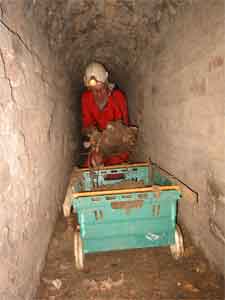

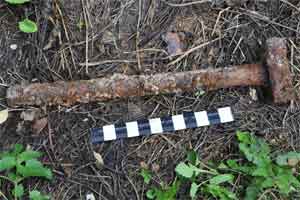

 Several robins have territories around the buildings, and are starting to 'inspect' the work in progress as they become accustomed to all the activity on site.
Several robins have territories around the buildings, and are starting to 'inspect' the work in progress as they become accustomed to all the activity on site.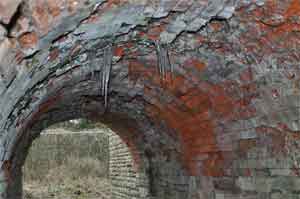 The first was on 04 February, though the arrival of snow in the afternoon brought proceedings to an early halt. One of the tasks was to clear up rubbish, made easier by the winter die-back of vegetation. The cold nights had created a crop of icicles in the passageway between the Horizontal Engine House and the New Pit heapstead, which had melted away by the next day. There were no icicles elsewhere on site.
The first was on 04 February, though the arrival of snow in the afternoon brought proceedings to an early halt. One of the tasks was to clear up rubbish, made easier by the winter die-back of vegetation. The cold nights had created a crop of icicles in the passageway between the Horizontal Engine House and the New Pit heapstead, which had melted away by the next day. There were no icicles elsewhere on site.
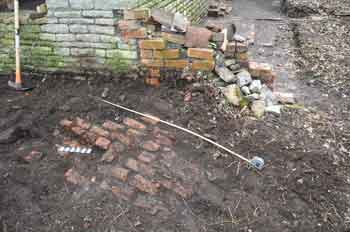


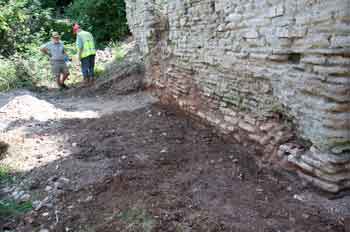
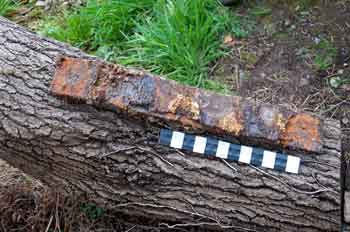
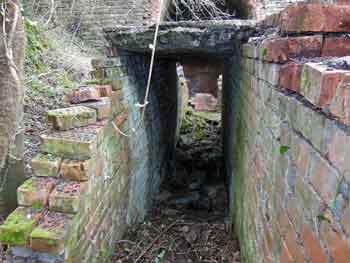 The rest of the stocks of recovered masonry were also consolidated.
The rest of the stocks of recovered masonry were also consolidated.
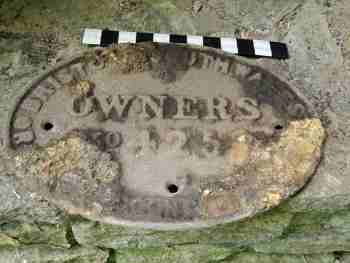


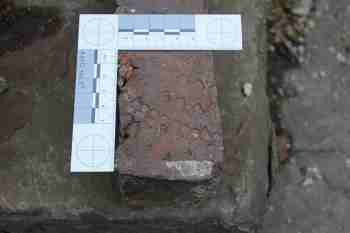
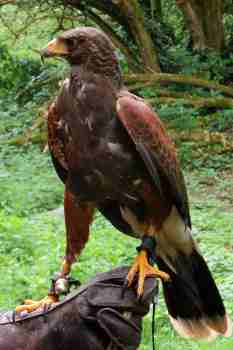


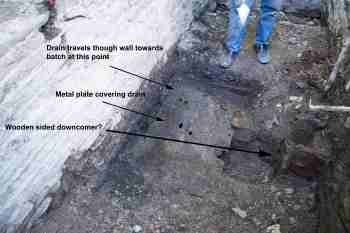
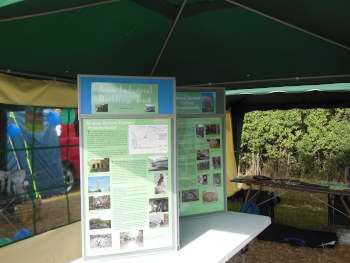
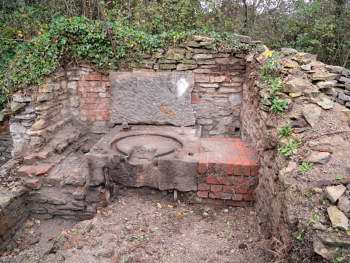
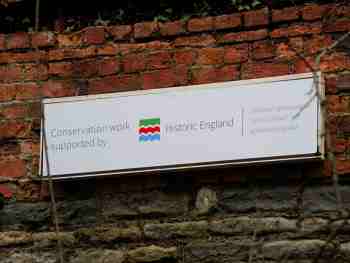
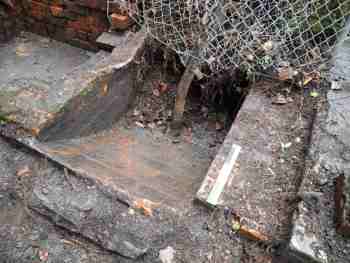
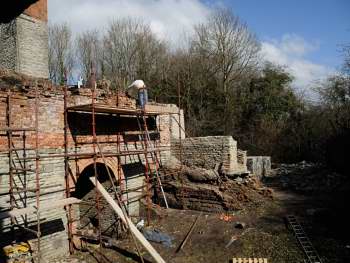


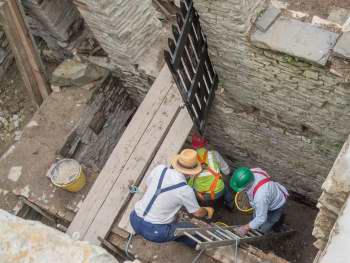

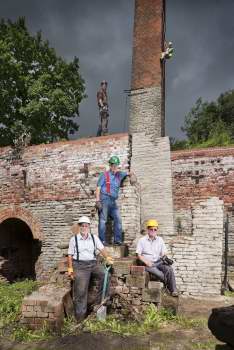
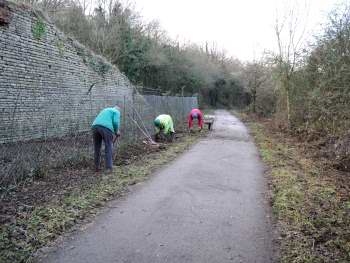

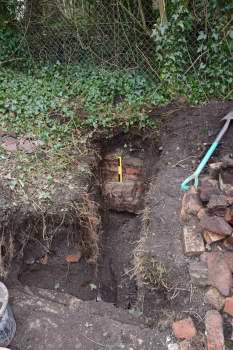
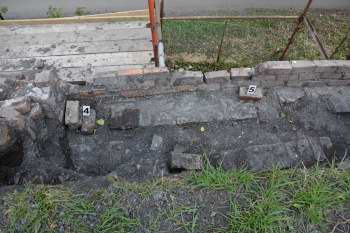


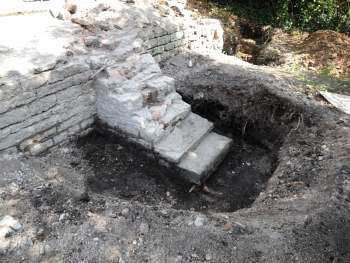
 uncovered outside the south-west wall of the Cornish Engine House. The stone surface had been removed out at some time in the past, leaving just one broken stone in place. This has been marked with an arrow in the photo, and the
uncovered outside the south-west wall of the Cornish Engine House. The stone surface had been removed out at some time in the past, leaving just one broken stone in place. This has been marked with an arrow in the photo, and the 

